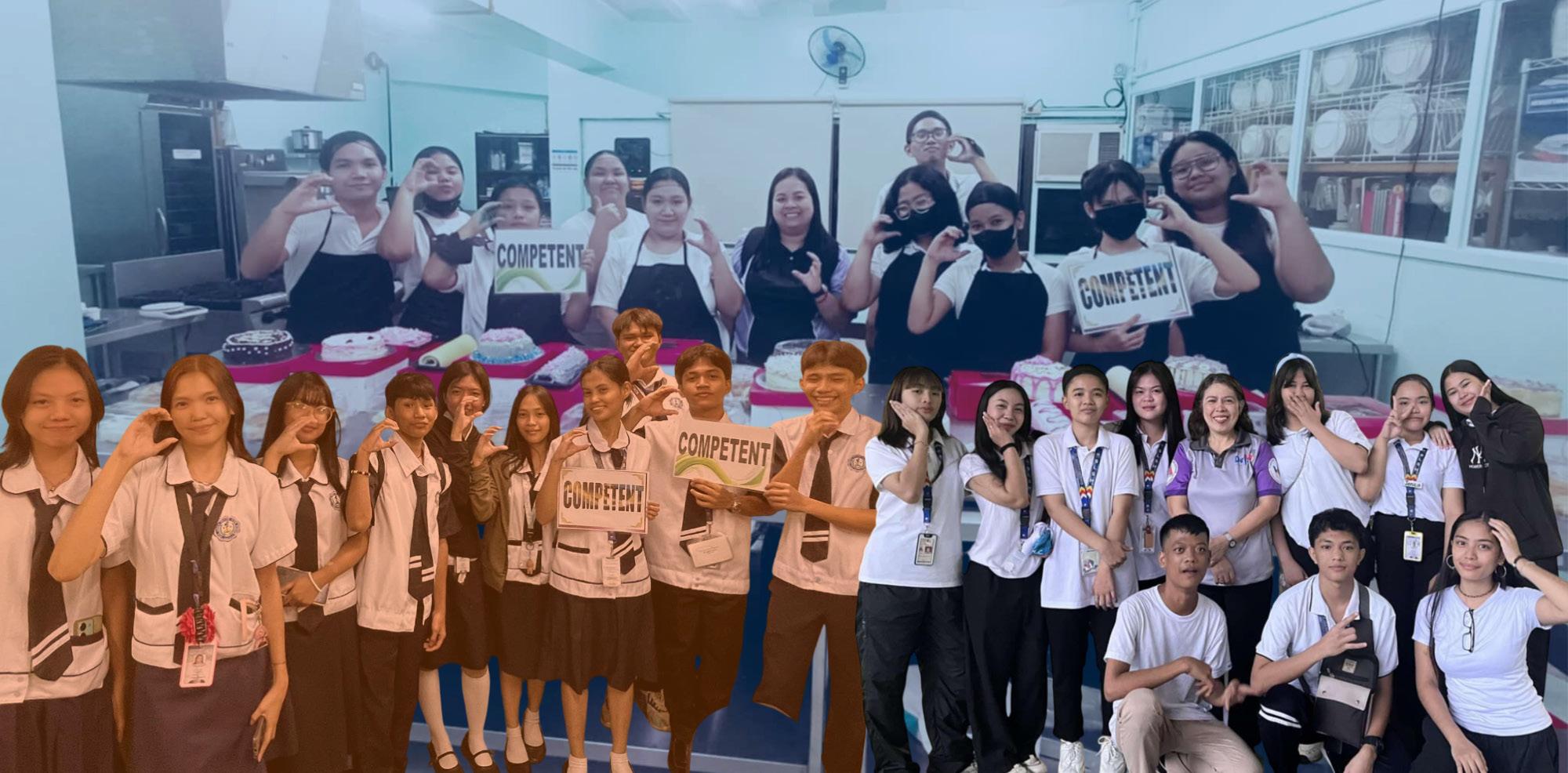
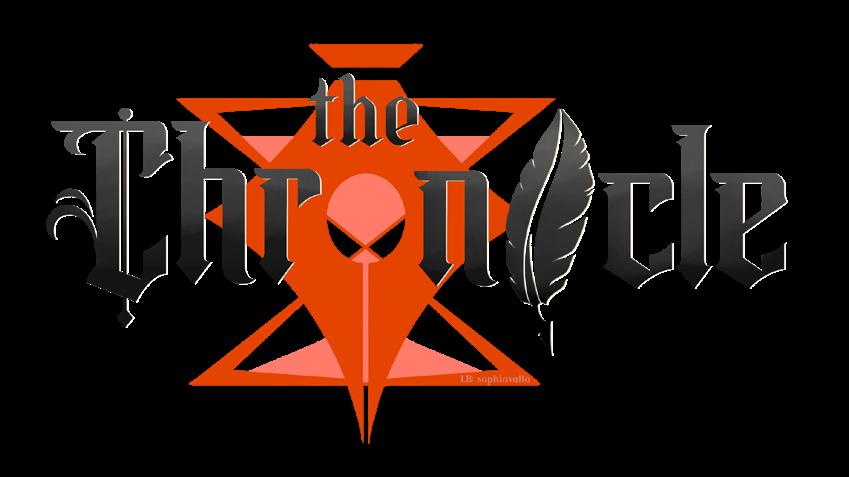



Sta. Lucia Senior High School (SLSHS) proudly announces its outstanding achievement of a 100% passing rate in the recent Technical Education and Skills Development Authority (TESDA) National Certification assessments. The successful assessments took place on December 17, 2024, and February 4 and 12, 2025, at the SLDM Colleges of Quezon City Assessment Center.
A total of 30 students from the Bread and Pastry Production (BPP) strand and 10 students from the Visual Graphics Design (VGD) strand passed their respective assessments, making all of them official holders of the TESDA National Certificate (NC).
“This marks our fourth year of conducting TESDA National Assessments for our Technical-Vocational-Livelihood (TVL) students. To date, we have produced over 100 competent and certified
graduates, and that is truly something to be proud of,” shared Ms. Bacuño, one of the school’s dedicated teacher-trainers, during an exclusive interview.
Ms. Melanie Kaguing, Grade 11 BPP teacher-trainer, emphasized the rigorous preparation undertaken by the students. “The students went through a long and demanding semester of training, designed to ensure they were fully prepared for the assessment,” she said.
Ms. Antonette Castillo-Ador, the VGD teacher-trainer, also highlighted the importance of flexibility and access to technology in student success.
“Even though the students had varying schedules, I ensured that their training remained uninterrupted. The availability of laptops significantly helped, allowing them to work independently and efficiently,” she explained.
Ms. Castillo-Ador further praised the creativity and resourcefulness of the VGD learners, describing these qualities as key factors that contributed to their success. “Creativity is an innate skill they all possessed, and it played a major role in helping them excel in the TESDA NC,” she added.
In line with its commitment to developing industry-ready graduates, SLSHS is currently training its Accountancy, Business, and Management (ABM) students for the Bookkeeping National Certification, under the supervision of Ms. Mary Joy Villasis.
This continued excellence in technical-vocational education reflects Sta. Lucia Senior High School’s dedication to empowering students with practical skills and national qualifications that enhance their employability and future career opportunities.


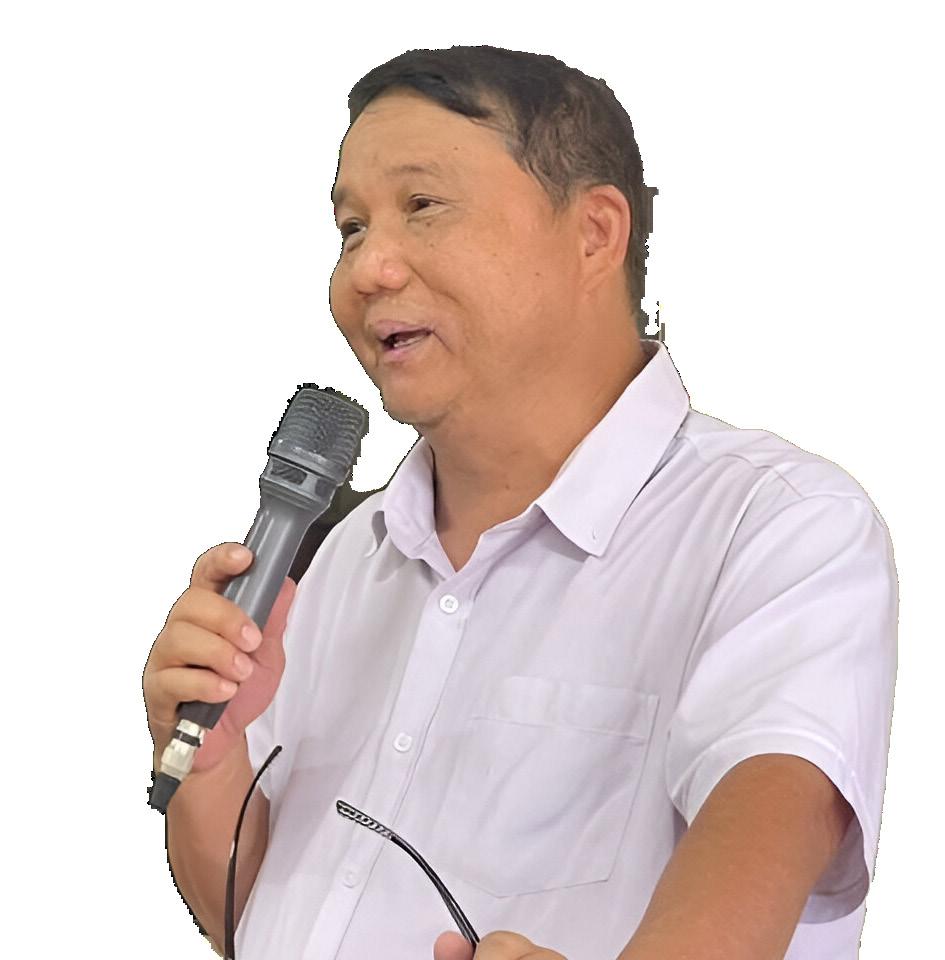
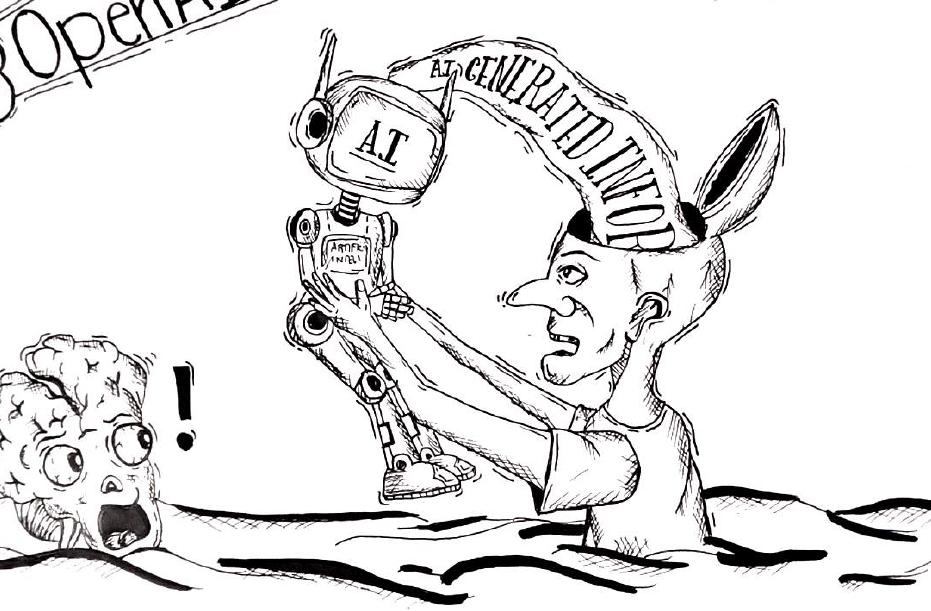
he Department of Education (DepEd) aimed to reduce the core subjects in the Senior High School (SHS) curriculum to five or six in response to the concerns raised regarding the employability status of the SHS graduates.
Proposed by Senator and now DepEd Secretary Sonny Angara in November 2024, the initiative sought to enhance the job readiness of Senior High School graduates by streamlining the curriculum.
Senator Angara emphasized that the current SHS curriculum, which covers numerous core subjects, has not adequately equipped students with the necessary skills to enter the workforce.
The proposal focused on the need for enhancement of practical knowledge and essential skills in preparation for future employment.
The plan has sparked mixed reactions
from SHS students, with many seeing it as a way to reduce academic pressure and focus on relevant skills.
Others, however, worry about potential gaps in foundational education if the number of core subjects is reduced.
A survey of 50 students from Sta. Lucia Senior High School revealed that 36 (72%) agreed with the proposed reduction of core subjects, while 14 (28%) disagreed
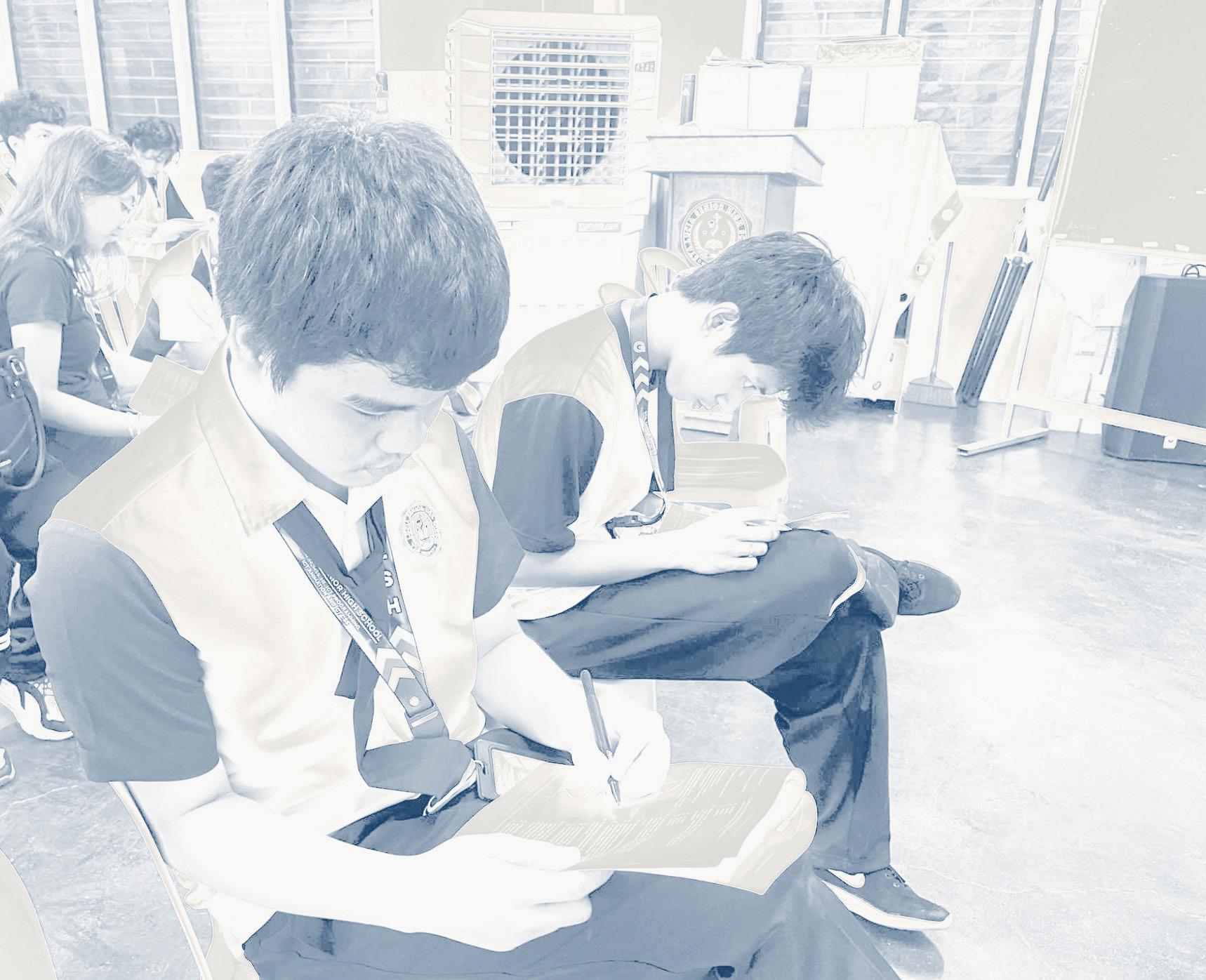
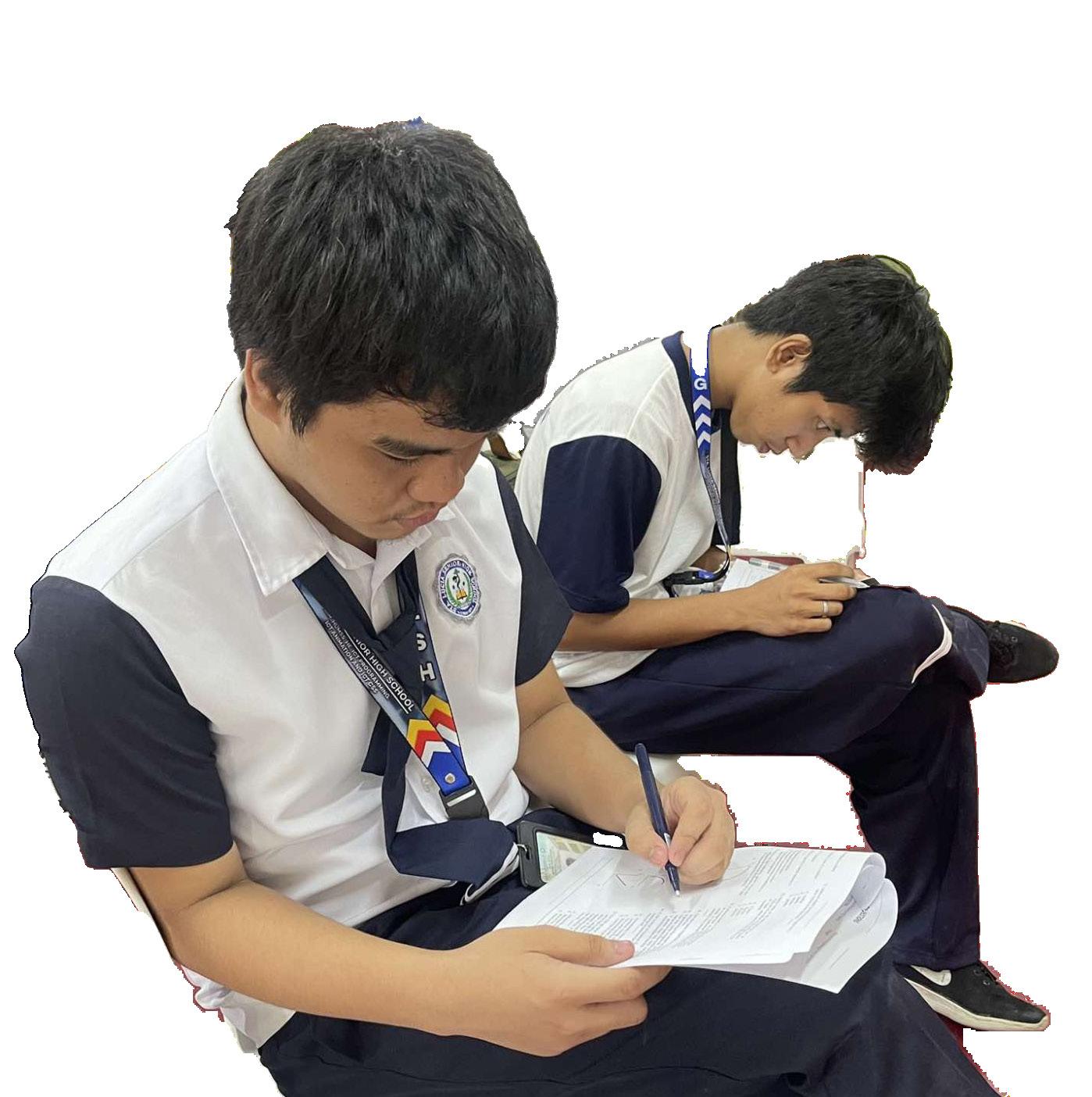
JOHN ANDREY FRANCISCO
Are you dreaming of studying in one of the prestigious universities in Metro Manila? Then your dream would become a reality by joining the school-initiated project titled “College Ready: College Entrance Tests (CETs) Review Sessions” spearheaded by the Supreme Secondary Learner Government (SSLG) under the supervision of Ma’am Joana Marie Bacuño as the adviser.
The project has been moving forward since September 16 and has already finished its pi-
lot implementation. It continuously progresses with the help of the alumni serving as facilitators who are currently studying in State Universities and Colleges (SUCs) like UP, PUP, PNU, among others. Some of the Grade 12 learners from various strands are presently enrolled in the program and attend the review session right after their scheduled classes. It is expected to last until February 2025 prior to taking the entrance examinations, according to the SSLG.
“By having these review sessions, it can help students
gain confidence and background knowledge they need for the upcoming entrance exams in some colleges.”, said Ace Nicolas, SSLG President, in an interview. He also added that with the help of the alumni by sharing their expertise and experiences, the project would be a success.
Meanwhile, the review sessions are still incessant despite various school activities. And the SSLG adviser is still looking for other qualified alumni who are willing to serve as facilitator in the upcoming weeks of its implementation.


Quezon City Vice Mayor Gian Sotto showed up and joined the ELEVATE session on November 13, 2024.
The session, held at the school’s Multifunction Hall, was attended by student-leaders along with the teachers and ELEVATE team.
The Vice Mayor delivered his opening remarks and shared his personal experiences to inspire and encourage them to continuously promote good leader-
ship.
SK Chairperson, Xyrone Pelayo, Mrs. Kristine Nomabilis, the school’s ELEVATE Focal Person, and the School Principal, Mr. Noel Valerio, were also present during the event.
The discussion was led by Mr. Otep Ortega, ELEVATE coordinator. He engaged the participants with a meaningful discourse about the purpose of life.
A soulful prayer, which he also led, marked the closing of the session.

EMERSON JAVILLONAR
Aiming to spread awareness on the status of Human Immunodeficiency Virus
(HIV), the Sangguniang Kabataan (SK) of Sta. Lucia conducted a seminar titled: “HIVe Minds: Know Your Status” on August 29, 2024, at the school’s triangle in celebration of the “Linggo ng Kabataan” . HIV and AIDS Support House, Inc. (HASH) Representative, Istifen Dagang Kanal served as the guest speaker of the event. He engaged the participants with an in-depth discussion and provided fruitful information about the significance of HIV awareness in the community.
The seminar further high-
lighted the breaking down of stigmas about HIV and AIDS. Modes and principles of transmission, ways to prevent, and statistics about this virus were also brought up. An open forum took place after the talk to clarify matters as regards the topic concerned.
SK Chairperson, Xyrone Pelayo along with SK Councilors and Committee on Health Chairperson, Fers Mae Galvez led the event. It was participated by the SSLG Officers, Club Presidents and Homeroom Officers of SLSHS.
The event concluded with the handover of HIV testing kits to student-participants to keep them abreast of their HIV status.
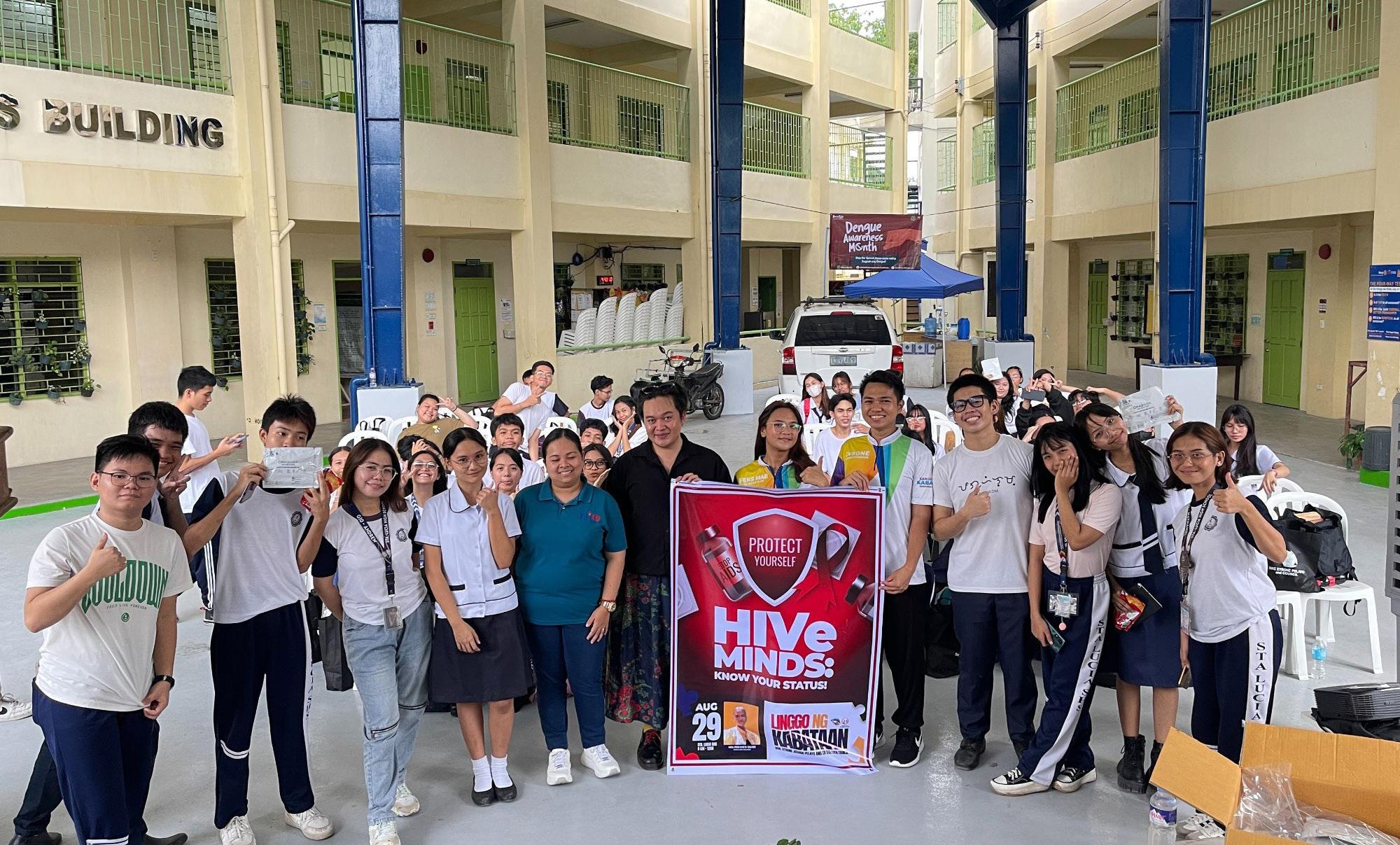
Quezon City Mayor, Ma. Josefina
“Joy” Belmonte, who was named as a United Nations Champion of the Earth for Policy Leadership, is currently recognized as one of the Forbes top 50 sustainable leaders in her efforts against climate change.
Belmonte, alongside C40 city members, as well as various entrepreneurs, scientists, investors, politicians, and activists, made it to the prestigious list leading global efforts to combat the climate crisis.
“These honorees recognized as Forbes inaugural Sustainability Leaders span industries, showed disciplines while demonstrating exceptional ambition, innovation, and tangible impact that is both scalable and sustainable,” Forbes stated.
Belmonte showed gratitude over the recognition of Quezon City’s efforts to combat climate change and its effect on the environment.
She added that this would also inspire the local government to continue discovering and implementing vital solutions that contribute to a healthier planet for the current and future generations and how we need to act fast and decisively on this problem.
Forbes commended Belmonte’s decision to place Quezon City under a climate emergency shortly after taking office as QC mayor in 2019.
“That move allowed Belmonte to allocate 13 percent of the city’s budget (which has since increased) to climate initiatives to
reach its stated goals of reducing greenhouse gas emissions by 30 percent by 2030 and reaching net-zero by 2050,” Forbes said.
Forbes also praised Belmonte’s various initiatives that included doubling the city’s bike path network to 217 kilometers, free electric bus services, and installation of solar panels on public buildings. Banning of plastic bags and single-use utensils, introducing a trashto-cashback program and creating a telling station for household liquid products were also added.
Just last year, Belmonte identified sustainability, environment protection, and climate resilience as some of her strong advocacies.

The Quezon City Police District (QCPD) celebrated its 85th founding anniversary on November 25, 2024, at the Meetings, Incentives, Conference & Exhibits (M.I.C.E), Quezon City Hall, recognizing the dedication and excellence of its personnel, units, and stakeholders in upholding public safety and community welfare.
With the theme “Tayo ang QCPD: May Dangal, Disiplina at Kasanayan, Kaagapay ng Pamayanan Tungo sa Ligtas at Maunlad na Bukas,” the event featured the conferment of awards and Plaques of Appreciation to outstanding individuals and units for their exemplary service.
Among the awardees were Lt. Col. Vicente L. Bumalay, Jr. (Best District Di-
rectorial Staff Officer of the Year), Lt. Col. Romil C. Avenido (Best Station Commander of the Year - Batasan Police Station), Maj. Don Don M. Llapitan (Best Police Commissioned Officer of the Year - CIDU), PEMS Nestor De Guzman (Best Senior PNCO of the Year - SCADS-PS 15), Cpl. Mary Kris Aguirre (Best Junior PNCO of the Year - PS 7 SDEU Operative) NUP Agnes Flores (Best Non-Uniformed Personnel of the Year - DPRMD) Lt. Col. Leonie Ann Dela Cruz (Gawad Maria Josefina “Joy” G. Belmonte Award as Policewoman of the Year - Kamuning Police Station).
Special awards were also given to high-ranking officers, including Col. Amante B. Daro, Col. Rodrigo Bauto, Jr., Col. Joel A. Villanueva, and Col. Jerome D. Balbontin, for their leadership and con-
tributions to the QCPD’s mission.
For unit awards, the Criminal Investigation and Detection Unit (CIDU) and the District Anti-Carnapping Unit (DACU) were recognized as the Best District Operating Units, while the Batasan Police Station (PS 6) was named Best Police Station of the Year. Other notable awardees included the Criminal Investigation and Detection Group-District Field Unit (CIDG-DFU) as the Best National Operational Support Unit and the District Medical and Dental Unit (DMDU) as the Best National Administrative Support Unit.
The event acknowledged key stakeholders for their continued partnership, including Mr. Deck A. Pelembergo of the Quezon City Task Force Disiplina (QCTFD), Mr. Dexter Cardenas of the Traffic
SOURCE: Presidential Communications Office
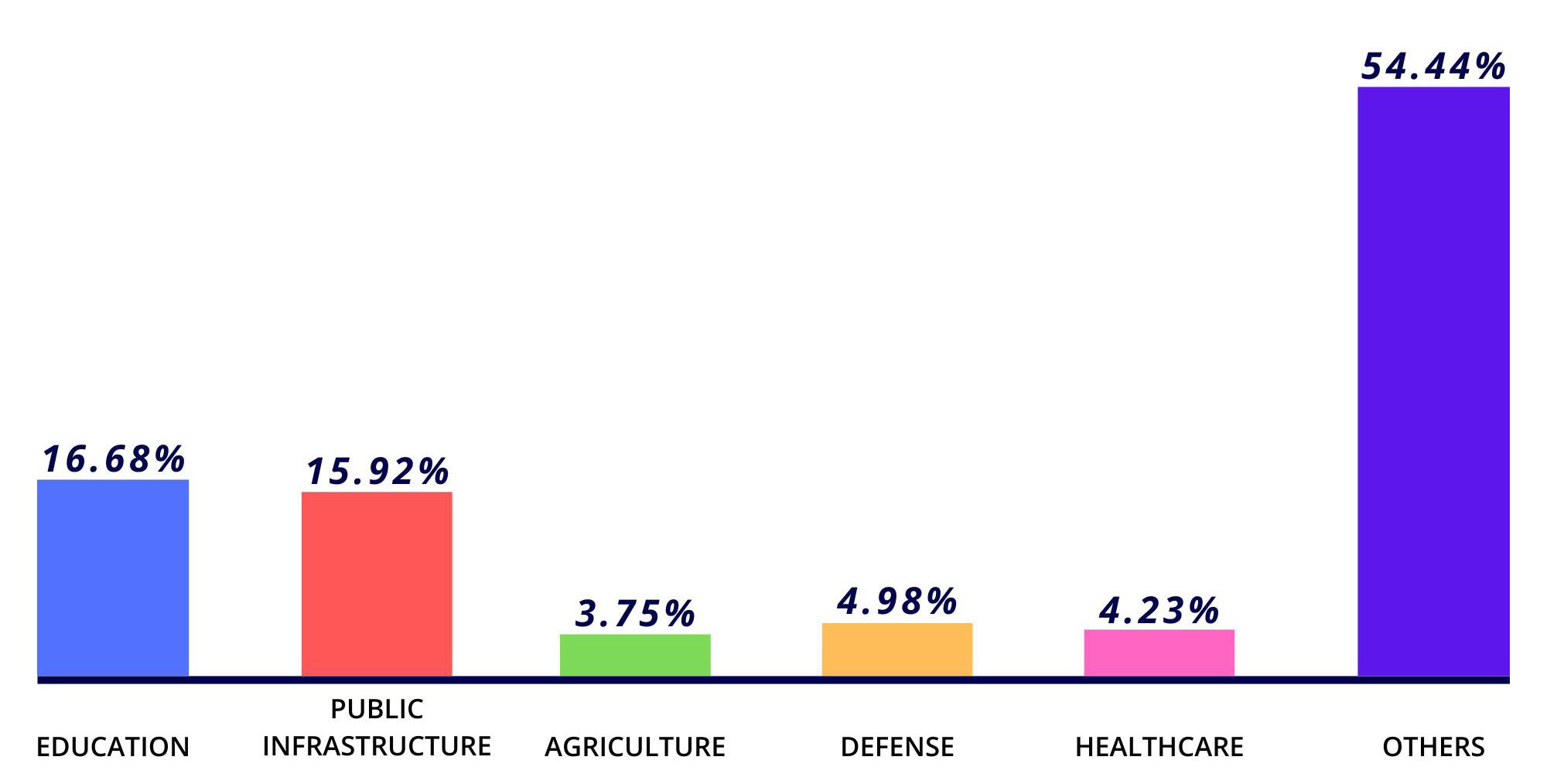
EMERSON JAVILLONAR
T
he Comprehensive Sex Education (CSE) Bill, filed in the Philippine Congress in 2023, aims to introduce age-appropriate sex education in schools nationwide.
In 2021, the Philippines recorded over 150,000 teenage pregnancies, with around 10% of them involving girls aged 10 to 14, according to the Commission on Population and Development (POPCOM).
Advocates, such as former Education Secretary Leonor Briones, argue that the bill will help reduce these alarming
statistics by providing students with proper knowledge on reproductive health.
However, some groups, including the Catholic Bishops’ Conference of the Philippines (CBCP), express concerns that the bill undermines Filipino values and parental rights.
If approved, the CSE Bill will require schools to teach topics like sexual rights, consent, and gender equality, starting from elementary through high school.

based on a survey with responses from 50 students at Sta. Lucia Senior High School
and Transport Management Department (TTMD), and Executive Director Alfredo M. Foronda of the Quezon City Anti-Drug Abuse Advisory Council (QCADAAC).
Quezon City Mayor Joy Belmonte, in her message, commended the QCPD for its unwavering commitment to peace and order. Police Brigadier General Melecio Buslig Jr., QCPD Director, reaffirmed the district’s dedication to excellence and partnership with the community.
The anniversary celebration also marked the inauguration of new facilities at Camp Tomas B. Karingal to enhance operational efficiency, showcasing the QCPD’s resolve to adapt and improve in its service to the people.

PBBM signs ₱6.3 trillion budget, vetoes ₱194 billion
President Ferdinand Marcos Jr. signed the ₱6.3 trillion national budget for 2025, the largest in Philippine history.
The president vetoed ₱194 billion in proposed allocations, including items from the Department of Public Works and Highways (DPWH), aiming to support economic growth and improve public services. He stated that the vetoes were necessary to ensure efficiency and avoid unnecessary expenses. The Department of Education (DepEd) received the highest budget allocation at ₱1.053 trillion. This will fund public schools, free college education, and teacher training. Infrastructure projects were allocated ₱1.034 trillion to
build roads, bridges, and other public facilities.
The military’s modernization program was given ₱35 billion, a reduction from its proposed ₱50 billion. The government said other key sectors like healthcare and agriculture were prioritized.
To fund the budget, the government projects ₱4.64 trillion in revenue and a deficit of 5.3% of GDP. Marcos aims to strengthen tax collection and attract investments to close the gap. Marcos is optimistic about meeting the country’s 6% to 8% economic growth target and believes that the budget will improve the lives of Filipinos, especially the most vulnerable.
ANDRHEA SHANE DEEMOY
Quezon City recently increased its commitment to child protection and made a big push through a series of strategic initiatives devoted to protecting children’s rights and welfare.
In 2024, Quezon City Council enacted Ordinance SP-3295, S-2024, institutionalizing the Quezon City Unified Referral System for Child Protection that aims to manage the referrals, reports, and coordination of all child abuse cases across different agencies under the town’s leadership.
On top of that, Ordinance SP-3277, S-2024, was ratified to crystallize the partnerships of the Sangguniang Kabataan (Youth Council) with child-caring institutions to reach out to children in need within the city municipality.
In November 2024, Quezon City was the venue for the Children’s Summit on combatting Online Sexual Abuse and Exploitation of Children (OSAEC), which highlighted the call for col-
lective action to combat the digital threats to child safety.
To strengthen and widen the cub experience, the city trained Hotline 122 operators to handle response cases involving children.
This initiative, formed with World Vision’s Project Against Child Exploitation (ACE), equips responders with the right skills and abilities to manage sensitive cases.
In addition, Quezon City has embedded itself in the “Safer Cities for Children” project to end sexual abuse and exploitation through integrated urban child protection strategies, thus affirming the city’s long-term commitment to child protection.
Consequently, Quezon City is emerging as a bastion of hope and action in the promotion of the rights and well-being of children by combining legislation, strategic partnerships, and community social initiatives.
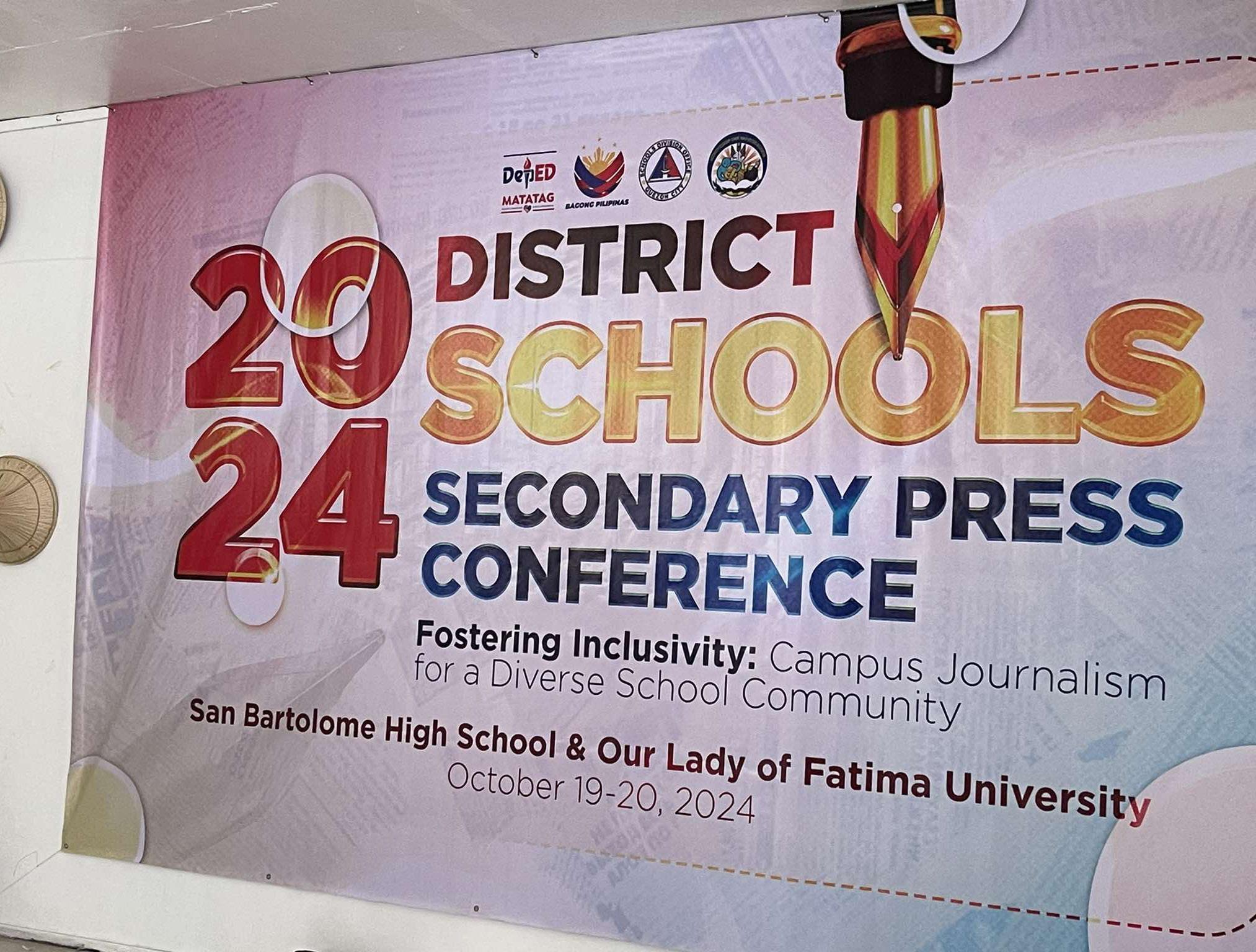

�� Ms. Joana
EMERSON JAVILLONAR
...Jennifer Sajulga, a Grade 11 student from Sta. Lucia Senior High School, said the reduction could ease students’ burden.
“Para sa’kin, the benefit of trimming the subjects of senior high school students ay mababawasan kahit papaano yung burden namin, kasi for me, hirap ako na masyadong marami yung subjects lalo na sabay-sabay yung need gawin and pagdating naman sa exam, nahihirapan akong aralin lahat dahil naghahalo-halo na yung mga lessons sa utak hanggang sa nalilimutan ko na or nawawala na yung lessons sa utak ko.”, she said.
However, a Grade 12 student from the same school expressed concerns about the disadvantages of reducing SHS subjects, say-
The campus publication of Sta. Lucia Senior High School (SLSHS), The SLSHS Chronicle, took part in the 2024 District Schools Press Conference (DSPC) held on October 19-20, 2024.
The event was hosted at San Bartolome High School on the first day, and Our Lady of Fatima University on the second day.
Students from various secondary schools in the Congressional District V of Quezon City participated, showcasing their skills in their respective categories. The SLSHS Chronicle had delegates for individual categories—
ing, “Kapag nagbawas o nagtanggal ng subjects sa SHS curriculum, mababawasan ang chance ng mga estudyante na ma-explore at ma-develop ang iba’t ibang skills na kailangan nila sa future. Halimbawa, ‘yung mga specialized subjects ay tumutulong para ma-enhance ang critical thinking, creativity, at technical skills na sobrang importante sa college o sa trabaho.”
“Kung magiging limitado ang mga ganitong learning opportunities, mas magiging unprepared ang mga kabataan lalo na sa mas mataas na edukasyon o career. dahil hindi sapat ‘yung basic subjects lang; kailangan ng well-rounded na curriculum para ma-meet ang demands ng modern world at mbis na magbawas, mas
including Copyreading and Headline Writing, Mobile Journalism, Sports Writing, Feature Writing, and Photojournalism.
SLSHS was also represented in group categories, namely Radio Broadcasting and Collaborative Desktop Publishing.
Ashton John Almorte, a layout artist and news writer of the publication, won 1st Place in the News Writing category.
Another win was captured by John Andrey Francisco, the publication’s Editor-in-Chief, who earned 9th Place in Editorial Writing.
Ghian Payawal recognized among top 22 scholars of CENTREX Batch 26
Ghian Carlo Payawal, a CENTREX (Center for Research and Excellence) Scholar from Sta. Lucia Senior High School, has been named one of the Top 22 Overall CENTREX Scholars for Batch 26.
The announcement, made on January 15, 2025, was followed by an interview at Commonwealth High School, where Payawal met other scholars nominated for the Top 22 spots.
“I’m honored to be among the Top 22 CENTREX Scholars, and I’m deeply grateful for the
unwavering support of my co-scholar, Emerson Javillonar, as well as my dedicated CENTREX Adviser, Ma’am Joana Marie Bacuño, and the school’s guidance delegate, Ma’am Mary Ann De Gana,” he said.
“I also want to thank everyone who supported us throughout our journey!,” Payawal added.
This recognition highlights the caliber of students from Sta. Lucia Senior High School and underscores the institution’s commitment to fostering academic excellence.
okay pa nga na mag focus sa pag improve ng quality ng pagtuturo.”, Christian added.
DepEd assures the public that the revised curriculum will maintain essential competencies while aligning with industry demands.
The department plans to involve educators, industry experts, and other stakeholders in the development process.
If implemented, the new SHS curriculum aims to provide a more focused education that improves graduates’ chances of securing jobs.
Further consultations and pilot tests of the proposed curriculum are scheduled in the coming months.
Sta. Lucia Senior High School (SLSHS) participated in the first day of Quezon City Division Secondary Schools Press Conference (DSSPC) 2024 at Quezon City High School (QCHS) on Friday, December 6.
The Chronicle, the school’s official English publication, had delegates for three individual categories — News Writing, Editorial Writing, and Sports Writing.
The second day of the DSSPC was also held at QCHS on December 7 for group categories.
On the other hand, the press conference concluded with the awarding and closing ceremonies at Don Alejandro Roces Science and Technology Senior High School on December 14.
SLSHS was among the schools that represented District V in the press conference, wherein all six Quezon City districts joined.


2024 - 2025
JOHN ANDREY FRANCISCO
Editor-in-Chief
EMERSON JAVILLONAR Associate Editor
VINCE ALDRAINE CHIQUINO
Circulation Manager
BRIGITTE VALERIO News Editor
CYRIL LORRAINE GARCIA Column Editor
EBONI JHEI-AR PAURILLO Feature Editor
ALTHEA LORIN LUCERO Science Editor
ACE BERNARD NICOLAS
Sports Editor
JHON VINCENT OBGUIA Cartoonist
ORLO ELIJAH LALU SHERWIN REY MONTERA PRINCESS ROSALES Photojournalists
ASHTON JOHN ALMORTE Layout Artist
CAILIN BACANI
ANDRHEA SHANE DEEMOY
AKISHA GAIL GUMANGAN
CHRISTIAN PO MORALDE
GHIAN CARLO PAYAWAL
KIAN AARON SUYOM
Writers
MR. ALJON B. TUSING School Paper Adviser
MR. NOEL N. VALERIO
School Principal
Amid the shifting tides of today’s educational landscape, the Filipino youth continue to strive— and survive—within a system that is both evolving and under strain. With former Senator Sonny Angara now at the helm of the Department of Education (DepEd), the agency pressed forward with renewed reforms. One major challenge lies in the push to return to the pre-pandemic school calendar, a move aimed at realigning the academic year to its traditional June–March cycle.
But in the rush to restore what once was, are we truly delivering meaningful learning experiences, or are we simply checking boxes in a curriculum? Are we prioritizing students’ growth, or just syllabi completion?
In April 2024, the Teachers’ Dignity Coalition (TDC) called on DepEd to end the 2024–2025 school year by April 11, 2024, in order to hasten the return to the old academic calendar. Their motivation was clear: to avoid the extreme heat experienced during the latter part of the 2023–2024 school year. On the surface, this initiative seems student-centered. Yet, its implementation triggered ripple effects that left
schools, teachers, and learners grappling with compressed schedules and overloaded workloads.
The early onset of Brigada Eskwela in July 2024, held during a brief break, saw students, teachers, and
non-teaching staff scrambling to prepare for the upcoming academic year. While the spirit of cooperation remained high, many schools found themselves ill-prepared, not due to a lack of effort but due to time constraints and an overcrowded calendar. What followed was an academic year marked by hastened instruction and mental fatigue. Teachers, under pressure to meet curriculum requirements, rushed through lessons. Meanwhile, students faced information overload—a deluge of concepts delivered with little time to reflect, apply, or truly understand. Breaks once meant for rest, such as the Semestral Break and Christmas vacation, were disrupted or shortened, leaving little room for recovery.
In effect, the drive to “restore” the school calendar became a trade-off—quantity over quality, deadlines over depth. The curriculum may have been completed, but at what cost to our
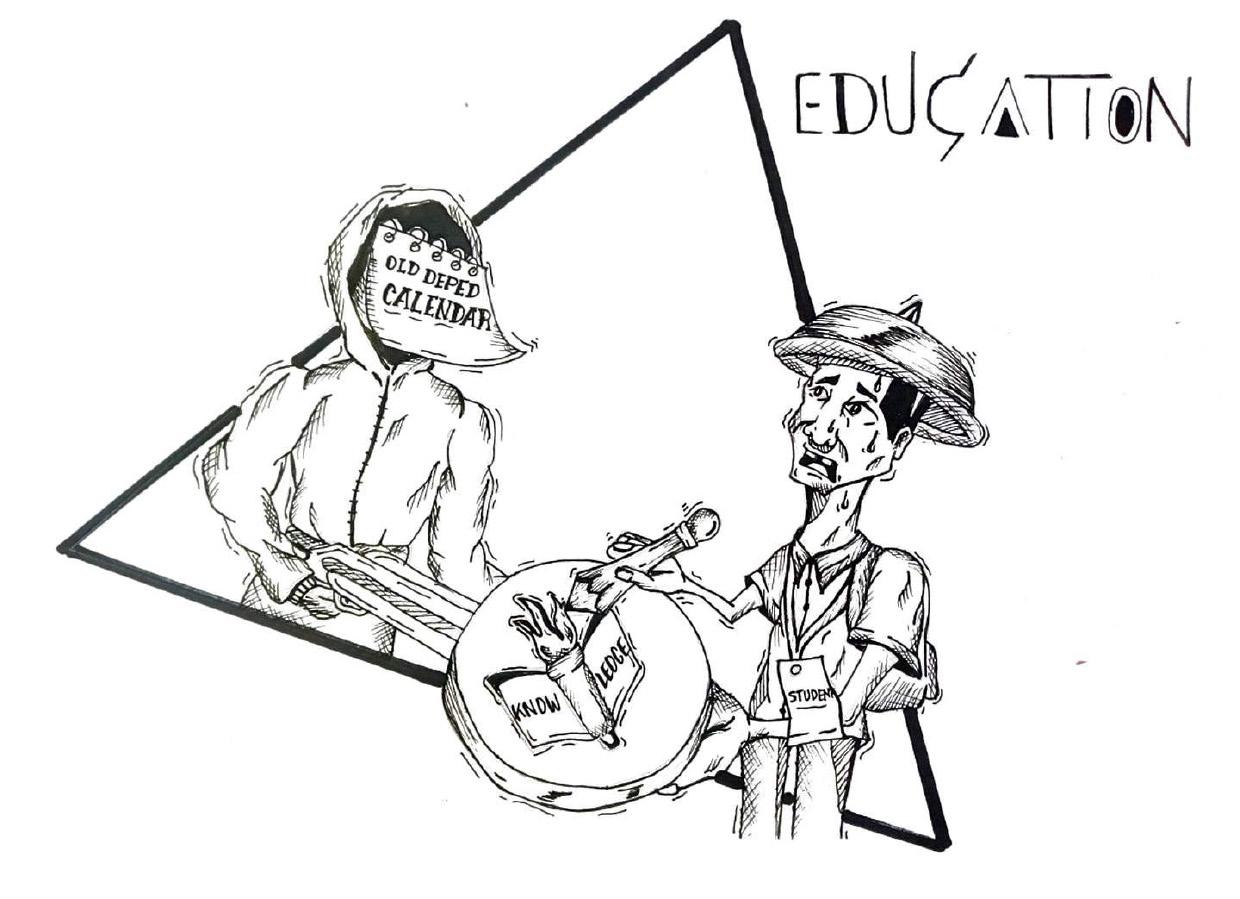
students’ comprehension and well-being?

The current education crisis is undeniable, but so too is the resilience of our teachers and students. While many of the reforms were well-intentioned—born out of concern for health and learning continuity—they must be measured against their real-world impacts. A rushed academic year, no matter how well-planned on paper, cannot substitute for a system that supports true learning. We must shift our focus from simply restoring schedules to redefining priorities. Education should not revolve around syllabi alone; it should revolve around students— their pace, their needs, and their capacity to grow. If we are to truly move forward, inclusive and well-calibrated planning is essential. Stakeholders—from government officials and school leaders to teachers and parents—must engage in honest dialogue about what’s truly best for learners. In doing so, we can create a system where reform does not come at the expense of well-being and where restoration never overshadows transformation.
In the end, education is not a race against the calendar. It is a journey of growth, curiosity, and critical thinking. If we are to honor the promise of education, then we must put students before syllabi, and always ensure that learning—not just lesson delivery—is our highest goal.
If a piggy bank without coins will not bear savings, so do children without knowledge of this certain phenomenon will not experience the savings it could bring to them.
News about CSE or Comprehensive Sexuality Education is now all over the Philippines. The said curriculum wants to establish a proper understanding and fix the common misconception about the concepts of sexuality.
According to UNESCO (United Nations Educational, Scientific and Cultural Organization), Comprehensive Sexuality Education (CSE), therefore, is a curriculum-based process of teaching and learning about the cognitive, emotional, physical and social aspects of sexuality.
What is holding us back from implementing this curriculum? This is the beginning of aligning the stars right for children’s sake. The things inside it can deeply be rooted on what their future will be. Would it not be a breath of relief to see them have a nice future
ahead of them, where the only thing they need to worry about is work and themselves?
CSE provides knowledge about their sexual health prior to the happenings in our country. Recent cases of teenage pregnancy had jumped to 35% last February 2024. It is now time we make people realize that it is not a miracle to be pregnant at an early age, but a responsibility which teenagers need to face in the present economy.
The overgrowing population will be the downfall and the uttered devastation for the Philippines. Through CSE, we can at least provide support through schools they go to. I had enough of the lack of sex education, and it is now that we make a change in the policies that not only ensure a quality education, but a future for these children.
The curriculum does not have bad intentions to them, but rather an eye-opener that can be a bit shocking from what we are used to. It covers a wide range of topics that helps their well-being and refrains them from aggravating the current situation of the country.
Letting children know the scope of sexuality is like adding coins to a piggy bank, it will be filled with the savings that could help them as time passes by.
For many students, the announcement of class suspensions during typhoon season often sparks joy. But for educators, administrators, and policymakers, it signals something far more complex: a race against time to ensure learning continues amid emergencies.
On December 23, 2024, the Department of Education (DepEd) released DepEd Order No. 22, s. 2024, a revised set of guidelines for suspending classes and work during various hazards, including typhoons, earthquakes, extreme heat, heavy rainfall, and power outages. At the heart of this new policy is the pursuit of a delicate balance—safeguarding learners’ well-being while ensuring uninterrupted education.
The order reiterates DepEd’s longstanding commitment to student safety while introducing stronger mechanisms for learning continuity, especially in disaster-prone areas. However, the pressing question remains: Is this vision as achievable in practice as it appears on paper?
A central component of the new policy is the reinforcement of Learning and Service Continuity Plans (LSCPs). These plans, now required to be updated every
three years, are meant to outline strategic measures for minimizing learning disruptions during emergencies. Essentially, schools must be prepared with clear roadmaps before disaster strikes.
But anyone who has worked within the education sector—particularly in vulnerable or under-resourced communities—knows the daunting reality of such planning. The execution of LSCPs demands time, manpower, funding, and infrastructure, all of which may be scarce in remote or disadvantaged areas.
Consider, for example, the implementation of Alternative Delivery Modes (ADMs) such as online and modular learning. While these options appear practical in theory, they are less viable in regions with unreliable internet connectivity or insufficient technological access. For many learners, “continuity” may still mean receiving photocopied modules weeks late or waiting for lessons sent via group chat—messages they cannot read due to spotty signals or lack of devices.
Another significant concern is teacher readiness. The transition to blended or remote learning necessitates a range of new skills, including digital literacy and content adaptation. Although the order implies upcom-
ing training sessions for educators, the burden of navigating these tech-driven shifts may once again fall on teachers themselves—many of whom already operate under tight schedules and limited support.
While DepEd’s intention to promote learning continuity amid crises is undoubtedly commendable, its success depends largely on the realism of implementation. Without adequate funding, thorough planning, and continuous support, the policy risks becoming yet another set of well-intentioned directives that falter at the grassroots level.
As the education sector adapts to an increasingly unpredictable climate, it must grapple with difficult questions:
Are teachers truly equipped for the tech-heavy demands of flexible learning environments?
Will schools be giv en the resources and autonomy to tailor continuity plans to their unique needs?
Or is this initiative—though visionary—another moment of dream versus reality?
Have you ever been on the verge of discovering a groundbreaking insight in an article—only to be met with a “Subscribe to read further” or “Pay X credits to continue” prompt?
Welcome to the world of paywalls. These digital barriers are designed to generate revenue for publishers through a sub scription-based model. Much like YouTube’s premium services, they require users to pay be-

fore gaining full access to content. On the business side, it’s an effective strategy— an undeniably successful tool for content creators, publishers, and researchers to monetize their work in an increasingly digital landscape.
On paper, the idea seems reasonable. Supporting creators so they can continue producing quality work? Fair enough. If I choose not to pay, I lose access—but nothing else. No harm, no foul.
But the issue becomes more complex when this model is used to restrict access to basic knowledge—especially when the content behind the paywall fails to justify its price. When access to vital information, research, or educational content is monetized without clear value in return, it raises a troubling question: Has the bar really sunk this low?
Let’s be clear—there’s nothing in-
herently wrong with supporting journalism or content creation through subscriptions. Prestigious institutions like The New York Times, Bloomberg, and The Guardian have mastered the art of monetizing content while maintaining quality, credibility, and a degree of public access. The key is balance—ensuring content behind paywalls is worth the price, and that essential information remains accessible. Unfortunately, not every platform puts in the effort to find that balance. Instead, what we often encounter are exaggerated headlines, shallow insights, and overpromised content locked behind expensive paywalls. This creates an experience not of informed engagement but of consumer frustration—leaving readers with the sense that they are being forced to pay for information that should, by all

logic, be public.
In many cases, the only thing these so-called “premium” articles manage to break is the reader’s expectation. The promise of groundbreaking knowledge turns into disappointment. It begins to feel less like investing in quality journalism and more like being exploited by a system that values profit over public good.
When we zoom out, the bigger picture is even more troubling. In an era where technology was supposed to democratize access to information, we are instead witnessing an increasing commodification of knowledge. What happened to research for the people? To accessible learning? To the very idea that education and enlightenment should not have a price tag?
And so, we return to the question: Is the bar really that low? In some cases—unfortunately—it just might be.
The Philippines’ performance in the 2022 Programme for International Student Assessment (PISA) once again casts a spotlight on the persistent challenges plaguing the country’s education system. The results placed Filipino students near the bottom of global rankings in reading, mathematics, and science—a sobering reality that demands urgent and collective action.
Released in December 2023, the PISA results revealed a continued underperformance in core competencies, with the Philippines ranking significantly lower than many of its Southeast Asian neighbors. Despite the introduction of various educational reforms in recent years, the gap in learning outcomes remains substantial. The Department of Education (DepEd) attributed part of this decline to the learning disruptions caused by the COVID-19 pandemic. However, these outcomes reflect not just the consequences of a global crisis, but also deep-rooted structural issues within the national education framework.
One particularly alarming revelation is the country’s poor standing in creative thinking, as highlighted in a Philippine Star report published in June 2024. In an increasingly complex and innovation-driven world, critical and creative thinking are no longer optional—they are essential. Unfortunately, the current system fails to nurture these competencies, treating them as supple-
mentary rather than fundamental to student development.
It is important to recognize that the pandemic merely exacerbated existing problems. Chronic issues such as insufficient funding, outdated pedagogical approaches, inadequate teacher training, and low compensation have long hindered educational progress. These challenges have contributed to significant inequality in learning outcomes, particularly disadvantaged students from rural and underserved communities.
Still, there is room for cautious optimism. The DepEd has reaffirmed its commitment to reversing this trend and has begun implementing recovery-focused initiatives. According to a BusinessWorld report from July 2024, the department is prioritizing teacher upskilling, curriculum revisions, and the integration of technology in classrooms. These steps aim to modernize the education system and better align it with the needs of 21st-century learners.
However, meaningful transformation requires more than incremental reforms. What the Philippines needs is a comprehensive, nationwide strategy that reimagines education as a tool for equity, empowerment, and long-term development. This includes: substantial investments in public education infrastructure and learning resources; equitable access to quality educa-
tion, particularly for marginalized communities; a shift in pedagogy from rote memorization to inquiry-based, learner-centered approaches; a culture of innovation in teaching practices and curriculum design; robust evaluation systems that go beyond test scores and assess critical life skills.
The country’s low performance in PISA should not merely be viewed as a statistic—it is a wake-up call. It signals the urgent need for collective commitment from all sectors: government, educators, parents, students, and civil society. Reversing the tide will not be easy, but it is not impossible.
At its core, education is the foundation upon which a nation’s future is built.
If the Philippines hopes to rise in global competitive ness, foster innovation, and uplift its people, it must begin with a radical rethinking and revitalization of its education system. The stakes are high, and the time to act is now.

AKISHA GAIL GUMANGAN
Living at the edge of constant technological revolution, Gen Beta is standing on the brink of a new epoch of childhood.
Born into an era of digital integration, these children – born after 2024 – will face challenges and opportunities that previous generations never faced.
Their trip will be directed by parents of Gen Z, children who a perfect fit in the digital world, yet are aware of the consequences of this digital world.
Gen Z, who are the most digitally fluent generation by parental measure, knows the good and bad of technology, and screen use, according to McCrindle Research. This dual perspective drives their approach to parenting.
Even though they recognize all advantages technology can provide both in the educational and social context, they also critique technology excesses and care about at what point and to what extent their children access technology.
The timing of the cloth becomes the
most important matter for these parents, screen time. What they are aiming for is to teach their children a strong sense of technology as a way to connect not to substitute for, real world connections.
For Gen Beta, digital interaction will be the default. Their links, education, and work will be challenged in a world of mix by hyper-connectivity as the only option.
McCrrindle Research, however, suggests that such children would make up for the lack of connectivity by acquiring a sense of personal expression in the creation and modification of their online identity by careful balancing of safety and maturity gifted by parents.
“Gen Beta will redefine the term belonging,” says McCrindle. They will be free to “naturally” integrate local, face-toface ties with causally distant, or remote, ties into the web of online social ties in a way to position that fosters home-oriented ties as well as ties across the globe.
The rise of Generation Beta underscores the dawn of a new societal era—
one shaped by technological breakthroughs, evolving social norms, and an increasing emphasis on sustainability and global citizenship. Yet, this hyper-connected world presents unique challenges. Somebody needs to answer the question of how much time is too much in screen space and how best to keep children safe from the world of online navigation whilst encouraging strong internet relationships in this screen-saturated society.
A particularly pressing concern is how these children will manage their digital identities. Unlike previous generations, who grew into technology, Generation Beta will be born into it.
Their capacity to create hyper-connectivity and uniqueness will impact not only themselves, but also their own personality and working life. For Gen Z parents, parenting Gen Beta is about utilizing their digital native background.
They understand the lure of technology but also recognize its pitfalls.
These parents are intentional about fostering balance, encouraging outdoor play, creative activities, and face-to-face socialization alongside digital engagement.
The focus is not just on limiting screen time but also on teaching children how to use technology responsibly. Gen Z parents are keen on equipping their children with the tools to navigate a digital
Sta. Lucia Senior High School warmly welcomes its new principal, Mr. Noel N. Valerio, an educator with an impressive 37 years of service in the field. Known for his unwavering commitment to excellence and his compassion for students, Mr. Valerio brings decades of experience and a deep sense of purpose to his role in his new school.
Before becoming a school head, Mr. Valerio dedicated his 31 years to teaching in the field, inspiring countless students and shaping lives. “Teaching has always been about more than just academics—it’s about guiding students to be the cornerstone of tomorrow.” he says.
world.
Encouraging critical thinking, digital literacy, and emotional intelligence. Generation Beta represents more than just the next cohort of children. They symbolize the beginning of a new societal chapter.
As McCrindle notes, this generation will grow up in a world where sustainability and global citizenship take center stage. Their values, preferences, and innovations will shape the future.
“They will grow up in a world shaped by breakthroughs in technology, evolving social norms, and an increasing focus on sustainability and global citizenship,” the research firm predicts.
Understanding and meeting their needs will be crucial for anyone looking to influence or engage with this generation. The journey of Generation Beta will be unlike any before it.
Raised by parents who are digital natives themselves, they will be equipped to navigate the challenges of hyper-connectivity while finding their unique voices in an increasingly individualized world.
For Gen Z parents, the task is clear to guide their children through the maze of technology with care and foresight, ensuring that they emerge not just as users of technology but as thoughtful, balanced individuals.
Generation Beta is more than a group—it is the embodiment of a new era, one where technology and humanity must coexist in harmony. Their success will depend on how well they can navigate this balance and how prepared society is to support them.
EBONI JHEI-AR PAURILLO
Mr. Valerio is not only a seasoned educator but also a man of strong faith. He values the spiritual development of the school community and has made it a priority to hold First Friday Masses every month. “Faith brings us together and guides us into making the students’ dream a reality,” he shares.
Despite his dedication to nurturing the school’s spiritual aspect, Mr. Valerio is firm about maintaining the school’s focus on academics. He ensures that these religious activities are thoughtfully scheduled to avoid disrupting classes. “Faith and education must go hand in hand,” he emphasizes.
Mr. Valerio’s strong faith influences his leadership style, grounding his decisions in compassion and principle. He balances his spiritual commitments with his role as an academic leader, ensuring that students receive both moral guidance and quality education. Evident in his words and actions, he earned respect both from the students and the faculty because of his unique approach to balancing faith and education because he believes that faith inspires everyone to do better and he is firm that Sta. Lucia Senior High School will be a living testament that it never hinders the learning process.
As he steps into his role, Mr. Valerio has clearly been practicing and emphasizing his visions and plans for the school community and the whole studentry. This includes creating an environment where students excel academically and be equipped with social skills that are essential in preparing them for life beyond the classroom. “It is important that they are more than ready for the real battle in the real world,” he explains.
Mr. Valerio also believes that fairness and collaboration must thrive in the whole school community to be able to create a just and inclusive learning environment as he knows that schools hold a crucial role in building and shaping one’s life which also affects how one acts in the society. “When one feels valued, they are more eager to learn,” he added.
Mr. Valerio hopes to leave a lasting impact on the students of Sta. Lucia Senior High School. His wish is for them to grow into individuals who embody love and respect for their families and communities, and be people of faith as he believes that it is the students’ guiding light to attain their dreams and reach their highest potential.
“I want our students to carry with them not only knowledge but also values,” he shares. “To be learners who cherish their families and contribute to their communities with all their heart and with purpose.”
Aside from being a principal at Sta. Lucia Senior High School, Mr. Valerio is a devoted father to his five children, all of whom have been and are scholars. “Being a parent myself, I want every student here at school to feel valued,” he says. His experiences as a great father have shaped his leadership style, “Parang ama,” as they say it at Sta. Lucia.
Mr. Valerio firmly believes that “the youth of today are the cornerstone of tomorrow” which has been his principle since, and is the driving force of his dedication and passion for education and his commitment to ensuring that the students of Sta. Lucia Senior High School both develop and amplify not only their academics, but their social skills as well.
With 37 years of service, 31 years of teaching experience, and a steadfast dedication to faith and education, Mr. Noel Valerio is a leader who inspires everyone around him with his pure intentions. His commitment to academic excellence, spiritual growth, and community-building promises to guide Sta. Lucia Senior High School into a brighter future.
“Education is not just a profession—it is my purpose,” Mr. Valerio says. “And it is to inspire students to dream, to learn, and to live with purpose.”


Time flies in ways we can barely grasp—taking moments with it, leaving some etched in our minds while others fade into the vast expanse of yesterday. It’s like hearing the first few notes of a familiar melody that takes you back, not just to a place, but to a feeling.
I find myself pausing and thinking: “Have we made a difference? Are we the change we wanted to see?” These questions echo in the hallways of Santa Lucia Senior High School, a place where students have turned ambitions into action and dreams into impact.
BRIGITTE VALERIO

“From classroom to community,” I whisper to myself, and the weight of what that truly means sinks in.
It started with a step—a hesitant yet hopeful step, much like a new dancer finding rhythm. The Home Economics students took that step, earning their NC II certifications. What seemed like mere pieces of paper soon became powerful symbols of competence and potential. As the certificates passed from one hand to another, you could feel it: this wasn’t just a school; it was a launchpad.
And then there were the moments that weren’t just about milestones but about meaning. The National Reading Month Culminating Program wasn’t just a celebration; it was a stage where voices rose, ideas bloomed, and literacy was more than a word—it was a cause.
It wasn’t all glitter and glory, though. We dug into the dirt—literally—with our hands planting trees at La Mesa Ecopark. We didn’t just talk about climate action; we became it. With every tree rooted in the soil, it was as if we were planting hope, one sapling at a time.
When the song changes in my
mind, I think of faces—students sitting side by side with police officers, united in the fight against illegal substances. It wasn’t just an event; it was a stand. We took to heart that our community is only as strong as our willingness to protect it.
I remember the adrenaline and the quiet moments. Standing tall on the taekwondo mat, we fought not just for medals but for discipline. Sitting still during Pastor Mark Balgos’s seminar, we listened—not just with ears but with hearts—about the strength to overcome life’s most daunting temptations.
There were times we stepped



Nof the year when the country celebrates the National Reading Month. Sta. Lucia Senior High School warmly welcomed the celebration with festivities that united everyone and made lasting memories.
SLSHS commenced the month celebrations with Storytelling Session, Poetry Writing Contest that started with a Virtual Author Meetup and Poetry Writing Workshop, Drop Everything and Read (DEAR), Book Hunt, and the grand culminating celebration with Mr. and Ms. Literacy 2024.
The Storytelling Session was made possible with the efforts of student teachers from University of Caloocan City. Thanks to Ms. Immaculate Hertz Santos, Mr. Joshua Bandalan, Mr. Mark Justine Nagar, Ms. Zaira May Natad, and Ms. Alysa Mae Boquiren, the stories came to life and left a wonderful mark on Grade 11 Senior Lucians who attended the event.
Ms. Bea Elisha Tumaque, bestselling author of “Letter from Nobody’s Girl”, “She Loved the Rain”, and “Two Strokes of Bad Luck”, joined in the school’s celebration as a guest speaker for the Virtual Author Meetup and Poetry Writing Workshop via Google Meet. The workshop ended with a seamless transition for the Poetry Writing Contest as she gave the prompt for the contest. Mary
back to give back. At the Holy Trinity Orphanage, we weren’t just students. We were brothers, sisters, friends— people capable of carrying love into places where it was most needed.
And when we stepped forward again, it was to lead. The SSLG took us there, guiding review sessions, representing us in the QC Junior Officials Program, and speaking for us in city summits. We weren’t just participants; we were pioneers.
The chorus of this journey rings loud and clear. We weren’t alone. It was in the applause of World Teachers’ Day, the laughter of Student-Teacher Week, and the quiet nods of the PTA meetings. We were never alone.
I close my eyes and imagine a future where this legacy lives on. Where every program, every initiative, and every small effort ripples outward—touching lives far beyond the gates of SLSHS.
I open my eyes and know: we’ve done more than learn. We’ve built bridges—between lessons and life, between the classroom and the community.
And when the melody finally fades, this remains: we made a difference.
Loraine Abad, from 12-HUMSS Brocka, emerged as the champion. She was followed by Jackilyn and Angela Casaberde, who earned first runner up and second runner up, respectively, as well as Mary Chen Gabiana, who gained special
Drop Everything and Read (DEAR) gave Senior Lucians an opportunity to showcase their favorite books to their peers. Grade 11-ABM
Adam Smith, Grade 11-HUMSS Martin Luther King Jr., Grade 11-HUMSS William Shakespeare, and Grade 12ABM Frederick Winslow Taylor were hailed as the “Optimal DEAR Classes”. However, out of all classes, only 13 students stood out among the rest. The students who earned the “Luminous DEAR Reader” recognition were Queen R. Cesar (Grade 11-ABM Adam Smith), Leo L. Leop (Grade 11-HUMSS Nelson Mandela), Aiko Sagun (Grade 11-HUMSS Martin Luther King Jr.), Ram S. Espulgar (Grade 11-HUMSS William Shakespeare), Honey Rose Q. Ortega (Grade 11 HE-Marie Antoine Careme), Cyprus John Q. Bulacon (Grade 11-ICT Programming Kevin Atienza), Lady Andrei R. Sierra (Grade 11-ICT Animation Stan Lee Animation), Trisha Mae L. Rivera (Grade 12- ABM Frederick Winslow Taylor), Alfred Sabido (Grade 12-HUMSS Lino Brocka), Joseph M. Padlan (Grade 12-HUMSS Fernando Amorsolo), Krizha Kim A. Agulay (Grade 12-HE Duff Goldman), Praise Mathieu J. Garcia (Grade 12-ICT Programming James Gosling), and Reynol M. Manalo Jr. (Grade 12-ICT Animation Walt Disney).
Here goes Book Hunt, a book scavenger hunt contest that sparked intrigue among the Senior Lucians.

The contest winners were split by grade levels. Anna Marie Christine Eulin, Glenn Anjello Dela Cruz, Laemiel Luiz Abarra, Pierre Dumdum, and Lawrence Isaac of Grade 11-HUMSS Shakespeare took the champion title for the event. The Grade 12 Senior Lucians, meanwhile, have Monique Napata, Angela Milan, Jeff Hardy Vergara, Eprehiem Bartolo, and Praise Mathieu Garcia of Grade 12 ICT Programming James Gosling as the Book Hunt Champions.
The most anticipated part of the month-long celebration, and the first ever one in the school’s history, is the Mr. and Ms. Literacy 2024. Candidates get to showcase their charm and brains as they compete for the pageant titles the event has to offer as the culmination of the National Reading Month was integrated in it. Students poured their all and were rewarded graciously as it made various lasting memories in their senior high school life. Ms. Monique Napata of Grade 12-ICT Programming James Gosling and Mr. Mark Ardie Pasiolan of Grade 12-HUMSS Mandela were hailed as the Mr. and Ms. Literacy 2024.
“It is necessary for the youth to recognize how being literate can be a useful tool for leadership. And by this event, may our students know the true value of reading and writing and how we can utilize it for our own interests,” John Andrey A. Francisco, the Editor-in-Chief of The SLSHS Chronicle and the overall in-charge of the event, stated in an exclusive interview.
“With the culmination of the National Reading Month via Mr. and Ms. Literacy, let’s all reminisce not only the joy that it brought to us but also the answers of each candidate on questions regarding literacy. As these answers will inspire us to strive for excellence and good leadership,” Francisco added.



Generosity flowed freely throughout the event. Snacks were provided by Mr. Leo and Mrs. Magda Larraga, offering the children a delightful treat. The games that followed brought uncontainable excitement, as prizes from generous sponsors added to the children’s joy.
The day was a vivid reminder that kindness can take many forms, from sharing a meal to offering a moment of happiness. The program emphasized the importance of uplifting others and showed how even the simplest gestures can create waves of positivity.

A Beacon of Hope
Project LUCIA transcended its role as an outreach program, becoming a symbol of hope and unity. It exemplified Sta. Lucia Senior High School’s unwavering commitment to creating an inclusive and compassionate environment.
Acts of kindness, no matter how small, carry the power to transform lives. On December 14, 2024, this profound truth unfolded through Project LUCIA—“Lucians Uniting to Care, Inspire, and Appreciate.” Organized by the Supreme Secondary Learner Government (SSLG) of Sta. Lucia Senior High School, under the inspiring leadership of Principal Noel N. Valerio, this outreach program became a beacon of hope and compassion at the Holy Trinity Orphanage.
PROJECT LUCIA was not just an event; it was a testament to the values that define the school community— unity, kindness, and a commitment to making a difference. Through thoughtful activities, creative expressions, and shared moments of joy, the program left a lasting impact on the children at the orphanage and the students who brought it to life.
The day began with an uplifting display of talent from the children at the orphanage. Their performances filled the room with laughter and smiles, setting the tone for the day. This celebration of creativity resonated deeply with Sta. Lucia Senior High School’s mission is to nurture and recognize the potential in every individual.
The children’s energy and enthusiasm served as a reminder of the importance of self-expression, which lies at the heart of the school’s educational philosophy. It was a moment where joy and inspiration intertwined, creating memories that would stay with everyone involved.
Adding to the day’s magic, the SSLG officers took the stage for a lively storytelling session. With animated narrations and interactive elements, they brought tales to life, sparking the imaginations of their young audience.
This simple yet impactful activity highlighted the value of meaningful connections and emotional growth. For the student leaders, it was an opportunity to share stories while inspiring hope and creativity among the children.
One of the highlights of the program was the art session, where the children painted characters using materials provided by Ms. Kristine Gamboa. This activity encouraged self-expression and creativity, reflecting Sta. Lucia Senior High School’s belief in the transformative power of the arts. At the end of the session, each child received a loot bag filled with surprises, a symbol of the collective effort of the SSLG officers, volunteers, and sponsors. This thoughtful gesture left the children beaming with joy and gratitude.
The day concluded with an inspiring speech from Principal Noel N. Valerio, who shared heartfelt words on the power of unity, kindness, and community. His message served as a powerful reminder of the school’s commitment to collective action and mutual support.
A shared meal, sponsored by Mr. Francois Mabuna, brought the program to a heartfelt close. This simple act of coming together around a table reflected the bonds of camaraderie and the warmth that defines the Sta. Lucia Senior High School community.
The program reminded everyone that even small acts of kindness can have a profound impact, leaving ripples of change in their wake. Project LUCIA was more than a day of activities—it was a celebration of humanity, a call for shared efforts, and a testament to the power of community.
Through the collective spirit of the students, staff, and supporters, Project LUCIA inspired a renewed sense of purpose and compassion. It was a day that echoed the values of Sta. Lucia Senior High School, proving that together, we can make the world a brighter and kinder place.

Years will come and go— as it is fated to happen. In these years, some remain remarkable and some are buried under the world. Listening to “Photograph” by Ed Sheeran really makes me nostalgic. Closing my eyes and opening my ears, I soon captured the strong feelings and what is yet to come. “Is this it?”, “Will we be the first?”, “Can we do this?”. It is the start, and we were the first ever set of campus journalists to publish a broadsheet in our Alma Mater, Sta. Lucia Senior High School.

And when it gets hard... You know it can get hard sometimes...
It is the only thing that makes us feel alive...
These three lines, we fit it like a newly tailored glove exactly our size. Doing it is not easy work. Comparing it to an ant with just a gram of rock, it is too hard to bear because of its weight. Articles written and pictures taken by the 19 campus journalists for each page, the minds all laid out, and the time spent to produce contents for everyone to read and appreciate.
As the song comes to the chorus, Holdin’ me closer till our eyes meet...
You won’t ever be alone...
Behind the success of PROJECT LUCIA was the dedication and teamwork of the SSLG officers. Led by President Ace Bernard Nicolas and Vice President Marian Faith Rimorin, the team worked tirelessly to bring the program to life. They were joined by Secretary Myca Azores, Treasurer Vince Aldraine Chiquino, Auditor Christian Po Moralde, P.I.O. Emil Gacula, P.O. Trexie Kaye Panado, Grade 12 Representative Maria Ana Ogad, and Grade 11 Representative Brigitte Valerio.
Through their leadership and collaboration, the event became a powerful example of what can be achieved when students come together to serve a greater purpose.
Sponsors, including Mr. and Mrs. Leo and Magda Larraga, Ms. Kristine Gamboa, and Mr. Francois Mabuna, played an integral role in ensuring the program’s success. Their generosity brought joy and hope to the children at the orphanage and inspired everyone involved to carry forward the spirit of giving.

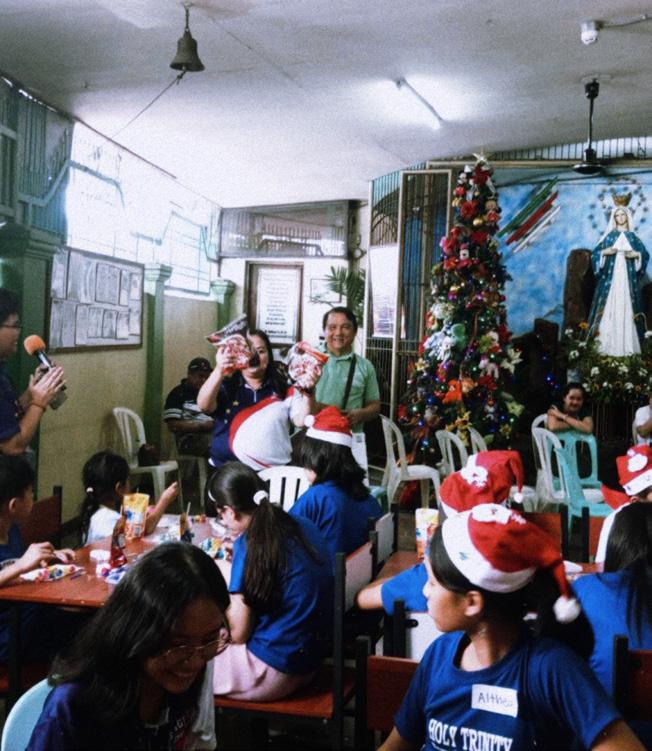
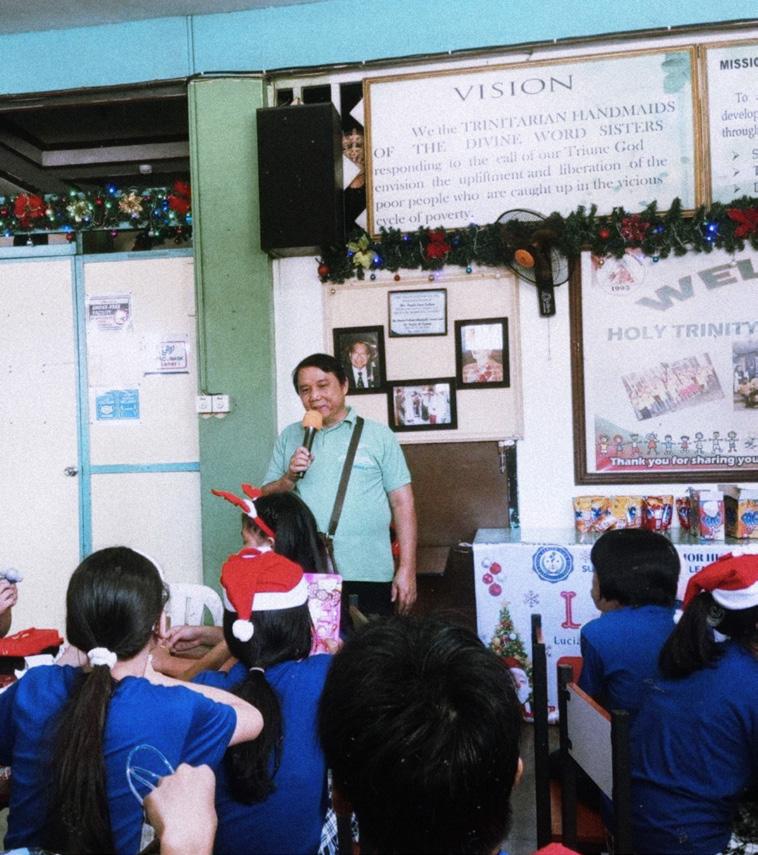
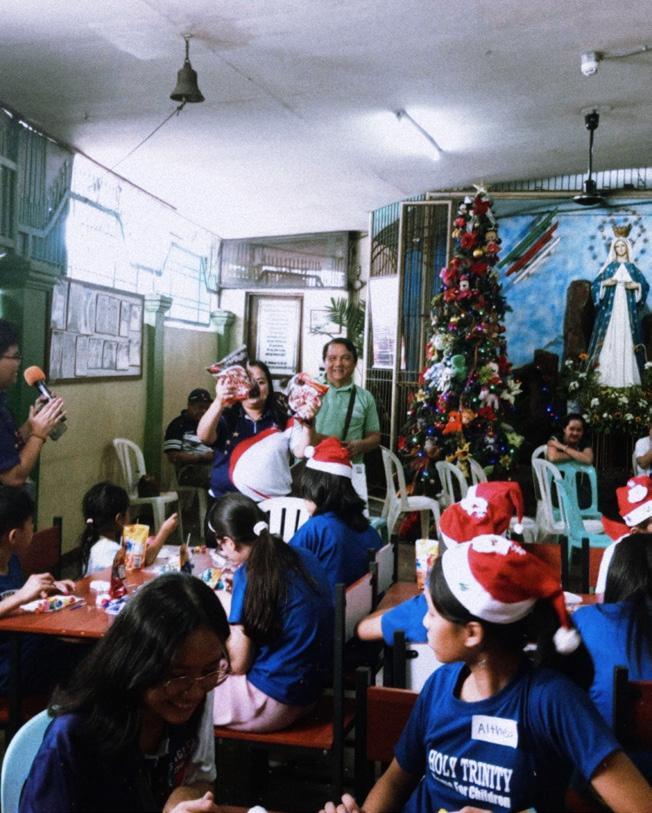

I was never alone. I was with them, creating legacy, making history, and putting memories up the wall of hope. Maybe it is tough work, but it does pay off. I breathe in and out, the curve of my lips showed up. We did it. We shared the same heartbeats, we were on the same pages, and we were holding each other towards one goal.
My eyes gradually open, the song nearing its end. All the flashbacks are flashing in mind, when we first attached our eyes in this broadsheet. The first moves we did, as if we were pawns on a chessboard. Bridging us towards reality — the success in the first
0:25 4:19
broadsheet of our school. The last seconds of the song, photographing it and capturing these moments are something to be placed near our hearts and souls.
Mm, we keep this love in this photograph...
We made these memories for ourselves...
First ones to create a legacy that lasts, even if time will pass.
CAILIN BACANI
As our technology continues to improve, certain devices are now being used as a way to help our daily lives but the increasing misuse of artificial intelligence (AI) tools among students is raising significant concerns about its impact on education and cognitive development.
A professor at De La Salle University, Dr. Benito Teehankee, while checking his students’ term papers, noticed that most of them were written perfectly in English but many students didn’t understand the written content. After further investigation, he discovered that students were depending on AI to do their work, which led to what he calls the “Stupefying Effect of AI,” where students are tempted to use AI generated content instead of their own thinking because there is more emphasis on fluency over factual accuracy, often resulting in nonsense.
Students are not the only ones following this trend. Professionals have also been sucked into the misuse of AI. For example, a lawyer in Colorado was suspended for fabricating case citations using AI and then lying about it. While in Australia, professors filed charges of misconduct against consultancy firms based on false allegations generated by an AI chatbot. These incidents show the dangers of being over reliant on AI with-
out verifying its results.
In the Philippines, the misuse of AI is especially concerning given the country’s existing educational challenges. According to international assessments in 2022, Filipino children are falling well short in basic disciplines including science, mathematics, and reading. The risk of increasing the gap between Filipino students and their international peers due to the misuse of AI and current educational issues emphasizes the importance for educators and policymakers to encourage ethical AI use while enhancing fundamental skills.
Dr. Benito Teehankee listed the things teachers can do in order to prevent misuse and improve learning, schools should educate on AI’s nature and proper uses, strengthen understanding of the nature of reality and knowledge, and clarify school AI use policy. He stated that “AI use is allowed only if explicitly stated by the teacher and for specific purposes. Students must cite their AI use and include the AI-generated di-
alogue as part of their submission. This ensures transparency and focuses on the student’s thought process.”
Educational institutions like De La Salle University (DLSU) is creating a trans-disciplinary program on AI ethics. These initiatives combine philosophy,
computer science, and management to promote ethical practices and innovation without losing honesty. With these, we can preserve the nurturing of a young student’s developing mind and help them continue being creative with their works.


Scientists from the University of Ateneo De Manila conducted research using the skin of Milkfish, (generally known as ‘Bangus’) and found that its skin could give doctors a more economical way to treat patients with massive burns and other skin injuries.
While not meant as a home ready, fish skin is proven to be an efficient alternative wound dressing for its ability to support and improve wound healing, specifically, skin injuries like burns.
As bangus is commonly raised and sold all throughout the Philippines, this research implies major implications for Philippine healthcare and offers the possibility of an affordable and viable wound care method that also potentially reduces the dependency of the country on imported medical materials.
“Among the eco-
nomically significant fish species in the Philippines, bangus is one of the most widely cultivated. However, limited research has been conducted on the suitability of milkfish skin for wound care, and given its abundance and potential collagen content, milkfish skin presents a valuable opportunity to expand the donor pool for fish skin grafting,” the researchers said in their paper.
The Ateneo scientists collected both bangus and tilapia skin from a local market in Metro Manila. Making sure that they were fresh and free of uncleanliness. The skin is then descaled, rinsed in saltwater and cut into strips and these samples were then sterilized in a solution called Silver Nanoparticles (AgNP).
The AgNP-infused bangus skin samples constantly showed complete inhibition of both bacterial and fungus growth and yet, un-
der the observation of a microscope revealed that the bangus skin samples manage to keep its collagen structural integrity similar and just as well as tilapia skin.
“By demonstrating that milkfish skin can be effectively sterilized and used similarly to tilapia skin, this research provides innovative, cost-effective, and sustainable wound-healing solutions. This finding has the potential to transform wound care in underserved areas, improving patient outcomes in regions with limited access to advanced medical facilities,” the scientists stated.
“This finding may have implications for the development of alternative, sustainable materials for medical applications, particularly in regions where these fishes are readily available,” the study finished.
ALTHEA LORIN LUCERO
PAGASA reported that the shear line will be affecting the eastern sections of Southern Luzon and Visayas, while the northern and Central Luzon, including Metro Manila will be affected by the Northeast Monsoon (Amihan).
Regions of Cagayan Valley, Cordillera Administrative Region and Central Luzon will have cloudy skies accompanied by rains due to the Northeast Monsoon (Amihan). Disasters like flash floods or landslides may possibly occur due to heavy rains.
Regions of Visayas, Bicol Region, MIMAROPA, Quezon and Dinagat Islands will have cloudy skies alongside scattered rains and thunderstorms, however, due to the shear line’s moderate to intense rains, flash flood or landslides are likely to happen.
In the case of the
rest of Mindanao, they would also experience partly cloudy skies with rain showers or thunderstorms and flash floods or landslides may occur.
On the other hand, Metro Manila and the rest of Luzon will only have partly cloudy skies along with light rains due to the northeast monsoon though with no significant impact.
For the wind speed forecast of each island group, northern and eastern Luzon would mostly likely experience moderate to strong winds, moving northeastward and moderate to rough coastal waters. In the meantime, the eastern section of Visayas will have moderate to strong winds moving from east to northeast direction and moderate to rough coastal waters.
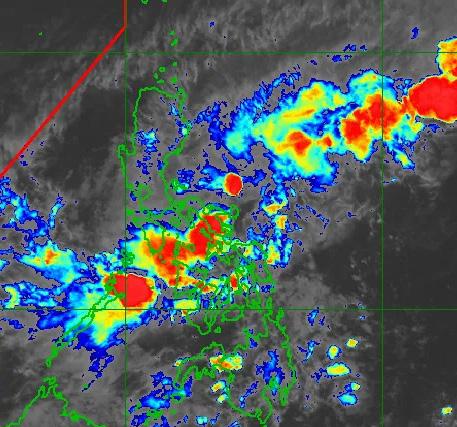

Located at the center of Luzon, Taal Volcano is one of the most beautiful yet destructive volcanoes in the Philippines. Whether it is the smallest active volcano in the world, with a height of 400 meters, its caldera is 25–30 kilometers in diameter and is surrounded by water. This active volcano tells a powerful tale of resiliency and change because of its explosive past, distinctive terrain, and cultural relevance.
The 623 square kilometer Taal Volcano Protected Landscape (TVPL) was first designated as a protected area in 1996 and then as a national park in 2018. It is home to over a million residents and hosts 52 migratory marine faunal species, including two endemic species.
Even though this volcano is extremely dangerous, many tourists still want to see it because of its beauty. Taal is
famously described as “an island within a lake, within an island, within a lake, within an island.” Due to the volcano’s continuous and constant eruption, the environmental change in Taal is evidence of how adaptable nature is. Species like the uncommon “Hydrophis semperi” sea snake and the endemic “Sardinella tawilis” sardines adapted to the new environment when the 1754 eruption transformed Taal Lake into a freshwater habitat. These species are now exclusive to Taal Lake, underscoring the remarkable interaction between evolution and geology.
According to Wikipedia, this small volcano can cause major damage. First, increasing in frequency of volcanic quakes with occasional seismic events accompanied by rumbling sounds. On the Main Crater Lake, changes in
the water temperature, level, and boiling of water occur. Before the 1965 eruption began, the lake’s temperature rose to about 15 °C (27 °F) degrees above normal. However, with some eruptions, there is no reported increase in the lake’s temperature. Increase in temperature of ground probe holes on monitoring stations. People may smell a strong sulfuric odor or irritating fumes similar to rotten eggs, and fishes will die and experiening drying up of vegetation.
No matter how small it is, the Taal Volcano is incredibly powerful and destructive. With its explosive history, unique biodiversity, and cultural legacy, Taal is a symbol of the delicate balance between beauty and danger.
A
team of Grade 11 students from Quezon City Science High School have developed an innovative artificial intelligence (AI) software named “Pintig,” designed to detect atherosclerotic plaques in the heart with remarkable accuracy. Cardiovascular disorders or Heart disorders are caused by atherosclerosis, which is the build up of fatty deposits, or plaques, which may clog the arteries. Early detection is crucial, yet traditional methods often identify these plaques only at advanced stages, leading to invasive and costly procedures. However, Pintig handles this challenge by performing
microscopic analysis on CT scan pictures, “Pintig actually examines each pixel of the CT scan image, even those as small as 50 micrometers—something not visible to the naked eye,” Tayko explained. With these capabilities, Pintig can be an essential tool in medical professions as it can highlight, detect, and classify the atherosclerosis plaque or clogging of a patient’s heart.
The development team, as stated by the student Kenzo Miguel Tayko, trained Pintig using a dataset of 14,000 CT scan images from approximately 200 patients. This extensive training has resulted in the software achieving an accu-
racy rate of up to 98% in plaque detection. To utilize Pintig, registered patients upload their heart CT scan images into the system, which then analyzes the images and provides a diagnosis within seconds, indicating the presence or absence of coronary artery disease (CAD) plaques.
The students’ has garnered significant recognition, earning them first place in the first Robotics Intelligent Machines in the previous regional science and technology fair. As we move forward, Pintig shows that AI has the ability to transform medical diagnosis, especially in environments with limited resources. It has the potential to improve patient
outcomes and lessen the need for invasive procedures by offering a non-invasive, accurate, and quick way to diagnose heart problems early.
Pintig’s achievement demonstrates not only the inventiveness of young Filipino entrepreneurs but also the revolutionary potential of incorporating AI into healthcare solutions around the globe. The success of Pintig not only highlights the inventiveness and creativity of young Filipino innovators but also demonstrates the revolutionary potential of incorporating AI into healthcare solutions around the globe.
Sta. Lucia Senior High School was fired up for the most awaited event of the Sports Festival—the basketball tournament! With both Grade 11 and Grade 12 teams bringing their A-game, Programming Atienza from Grade 11 and HUMSS Amorsolo from Grade 12 dominated the court and took home the championship titles. This intense matchup began on February 4, 2025, at the SLSHS Triangle and concluded on February 17, 2025.
In the Grade 12 division, HUMSS Amorsolo— featuring CJ Clark A. Mateo, Klark Arcquin D. Egnares, Tristan Kyle Laderas, Nathan Alexander M. Rea, John Cedric S. Valenzuela, and Zyron James E. Arensol— displayed remarkable dedication, strategic plays, and teamwork, earning them the championship title through their hard work and perseverance.
Following closely behind, 12 ABM secured the 1st runner-up position. The team, composed of Jack Mar R. Narrido, Eldrin James M. Marcelo, John Mark E. Pateño, Marvic S. Manalo, Aldred B. Villanueva, and Aeron Ashley G. Apat, fought fiercely until the end, putting up an impressive performance that secured their place.
Meanwhile, 12 CSS, represented by Edzraffil M. Diang, Stromile V. Riquez, Gian Carl A. Llamera, Melvin
J. Cañete, and Carlden A. Carlos, claimed second runner-up after delivering an outstanding performance, showcasing remarkable plays that proved their worth on the court.
The Most Valuable Player (MVP) for the Grade 12 category was Klark Arcquin D. Egnares from 12 HUMSS Amorsolo, who displayed exceptional skills and an unyielding fighting spirit. His leadership and determination were key factors in leading his team to victory, ultimately securing their championship title.
Additionally, the Mythical 5 award was given to Edzraffil M. Diang from 12 CSS, John Mark E. Pateño and Marvic S. Manalo from 12 ABM, and Klark Arcquin Egnares and Tristan Kyle Laderas from 12 Amorsolo, recognizing them as standout players for their respective teams.
In the Grade 11 Division, Programming Atienza, consisting of Jerry D. De Guzman Jr., Samuel A. De Luna, Kent Lester V. Famodulan, Janssen E. Lee, Jiovanni N. Maňoso, Jhon Russell Perez, and Mark Salloman, delivered a remarkable performance. Their unique playing styles and strong teamwork made them a formidable opponent, ultimately securing the championship title.
Not far behind, 11 HUMSS Shakespeare put up a tough fight until the final buzzer, securing 1st runner-up. The team—composed of Ram Espulgar, Jhon Michael Tono, Nelfer R. Masculino Jr., Arvin Mark Ercilla, and Ken Joseph Ballesteros—showcased resilience
�� Ms. Charismalyn Cantoria
SHERWIN REY MONTERA
Reyward Ibias emerged victorious in the Sangguniang Kabataan Sta. Lucia Chess Tournament 2024, held on November 3, outmaneuvering the top contenders at the Barangay Hall.
Ibias demonstrated exceptional thinking, checkmating his way on to the top. His precise moves and predictions earned him the champi-
onship title.
Jetro Macalipay, the 1st runner-up, and Glen Michael Navida, the 2nd runner-up, showcased their impressive skills and fought to the end to secure such respective podium places.
The Sta. Lucia Chess Club played a vital role in the tournament, providing equipment and technical expertise. Arnel Mahawan Jr. And John Paul Mahawan served as the
arbiter to ensure fair play, and the president engineer, Leandro Pajo, contributed essential resources.
This tournament solidifies chess as an emerging sport in the Sta. Lucia Community, thus, contributing to intellectual thinking growth. As the chess community grows, expectations rise for future competitions. Will Ibias defend his title? Or will new challengers emerge?
and determination throughout the tournament. Meanwhile, 11 ABM, featuring Carlos Domingo S. Barandino, Micael Yian T. Florencio, Leigh Jherson F. Quibina, and Emerson A. Javillonar from 11 Mandela, along with Jahn Ramsen Oraa from 11 Atienza, fought with iron will and pure dedication, claiming second runner-up in the competition.
The MVP of the Grade 11 division was Jiovanni N. Maňoso from 11 Programming, who played an outstanding game, leading his team to the championship title.
The Mythical 5 awardees for the Grade 11 division were Emerson A. Javillonar from 11 Mandela, Arvin Mark Ercilla and Nelfer R. Masculino Jr. from 11 Shakespeare, and Jiovanni N. Maňoso and Samuel A. De Luna from 11 Atienza, honoring them as standout players in their division.
This basketball tournament not only showcased the skills and dedication of Sta. Lucia Senior High School students but also united the school through sportsmanship and camaraderie. The excitement was evident in every game as students cheered passionately, playing their roles as athletes, supporters, and facilitators to make the event a success.
With the talent displayed, the thrilling competition, and the indescribable energy of the games, Sta. Lucia Senior High School is already looking forward to another basketball showdown next school year.


The UP Fighting Maroons team had a dramatic ending after the hard-fought battle against the DLSU Green Archers in the game three finals, securing the crown for the season 87 men’s basketball team with a 2-1 lead that took place at Araneta Coliseum, Quezon City, held on December 15, 2024.
After a consecutive heartbreaking silver place for two seasons, the UP Fighting Maroons regain their throne, led by the Finals MVP, Joel Diomar “JD” Cagulangan, who started his career as the UP Fighting Maroons champion in Season 84 and ended his collegiate career as a champion and Finals MVP this season.
As there was only a small gap in score in the 4th quarter and time reaching its end. Francis Lopez throws a sealing three-pointer that gives the UP Fight-
ing Maroons a four-point lead that makes the score 64-60, with one minute and 31 seconds more to go on the clock. Restoring his name from the errors he committed in the game two finals.
EJ Gollena from Green Archers found his way to push through after he made a layup, scoring two points for his team with 46.6 seconds left.
In the next possession of UP Fighting Maroons, Jc Cagulangan’s jump shot missed, and Gerry Austin Abadiano was able to get the offensive rebound and get a foul from Kevin Quiambao, giving a chance to UP Fighting Maroons to reposition.
With only 11.3 seconds left on the clock, Millora-Brown Quentin “MBQ” got fouled by DLSU’s Mike Phillips. QMB made his two foul shots that clutch and
seized the game with a score of 66-62.
Game three finals was a heart-stopping battle and a conversation of runs for both teams. DLSU Green Archers gave a great fight led by the two-time champion Kevin Quimbao. The defense of UP Fighting Maroons is a rock-solid defense that gives hardship to KQ and helps them reach success.
The groundbreaking record of 25,248 people who watched the battle in the arena saw the heartfelt ending of the UP Fighting Maroons as the final buzzer hit, and they realized that they conquered the UAAP season 87 men’s basketball team. UPFMT cannot contain the happiness and pride they had and make every team member emotional.
“First of all gusto ko magpasalamat sa Diyos, hindi niya kami pinabayaan; gi-
nuide niya kami nang maayos. Gusto ko magpasalamat sa lahat ng sponsors, dahil ang suporta nila ay lagi nasa amin... kay coach Gold, sa lahat ng coaches sub niya, sa tiwala na binigay nila sa amin... of course sa mga teammates ko, ito na, ang dami nating pinag daan, maraming pinag-usapan, salamat pare, salamat sa inyong lahat... And of course to the UP community, winelcome niyo ako nang maayos, winelcome niyo ako for four seasons, wala akong masabi sa inyo, maraming maraming salamat!” said by the Finals MVP, Jd Cagulangan, as he asked what his message and thoughts were after the game. After everything happened, he is very grateful to everyone that makes him lose words for so much gratitude.
A
fun yet fierce match occurred in Sta Lucia Senior High School when faculty teachers and non faculty staff showed their athletic and competitive side in an exhibition match in badminton, volleyball and basketball that turned the school into an arena. This took place on Sta lucia Senior High School Triangle on February 17, 2025.
Alongside the students’ championship battle in the Sports Festival, a friendly match between faculty members and non-teaching staff took place, adding excitement and fun to the event and giving a more thrilling experience for the students.
A sweaty and fun game took place first thing in the morning as badminton was the first game category played, featuring participants such as Ma’am Rosalyn J. Evasco, Sir Ace Angstrom Abanes,
Sir Aljon Tusing, Ma’am Joana Marie G. Bacuño, Ma’am Mary Joy U. Villasis, Ma’am Maria Jesusa S. Cariño, Ma’am Myra N. Francisco, Sir George M. Mabaquiao, and Ma’am Tina. This set the stage for a day where teachers played competitively while also enjoying themselves.
As the clock struck the time for the volleyball match, Sta. Lucia Senior High School was filled with an overwhelming sensation of joy, excitement, and thrill.
Ma’am Kathleen Kaye B. Rebanal, Ma’am Myra N. Francisco, Sir George M. Mabaquiao, Ma’am Rosalyn J. Evasco, Sir Ace Angstrom Abanes, Ma’am Ma. Jesusa S. Cariño, Sir Aljon Tusing, and Ma’am Joana showcased their skills on the court, delivering an entertaining and breathtaking battle. As the rally intensified, techniques,
athleticism, tactics, and strategic plays started to unfold, leaving the students in awe. The match ended with the court filled with laughter, amusement, and admiration from the students.
Meanwhile, in the basketball match, Sir Norlito A. Deligero, Sir Daryl Eldrin L. Valenzuela, Sir Ace Angstrom Abanes, Kuya Jomar, and Kuya Joseph stepped onto the court for an intense and exhilarating game. The moment the game started, the students went wild, especially as Sir George, Sir Norli, and Sir Ace displayed unexpected skills and plays that left everyone flabbergasted. Ma’am Rosalyn and Ma’am Sandy also took a turn on the court, subbing in along with Sir Ace to fully enjoy the match. This exhibition match not only showcased another side of the
teachers but also fostered unity and created a space for students to enjoy, have fun, and share the experience with them. It was a successful day as they completed their exhibition match to the fullest without disrupting the class schedule. Through this experience, they proved that they are not only exceptional in the classroom but also skilled in various sports. By the end of the event, students gained a new perspective on their teachers—their hidden talents and abilities—making them even more inspired and excited to play alongside them. After this match, students are already looking forward to the next game, where their teachers will once again give their all on the court, standing out not just as educators but also as players.


BRIGITTE VALERIO

Kick, block, and strike!
Sta. Lucia Senior High School was hailed victorious in Taekwondo during the District Meet, securing two gold and two silver medals. The intense competition was held at Lagro High School, yesterday, 12th of October 2024.
Paul Firmanes, who competed in the Welterweight Division, delivered a standout performance, earning the gold medal for his division. Firmanes showcased his skills with powerful strikes and well-timed blocks, pounding his opponents with precision and technique. His consistent execution in the match was key to his victory, putting SLSHS on the map in the competition.
Adding to the school’s victory, Sean De La Fuente also brought gold medal in the Flyweight Division. De La Fuente’s speed and agility were on full display, as he maneuvered his way through the matches with sharp counters and swift footwork, securing his place at the top of his division.
Leo Leop, who also competed in the Fin Weight Division, fought bravely and finished with a silver medal. Reflecting on his
match, Leop shared his thoughts: “I was quite disappointed, but at the same time, I’m happy. I expected Gold but got Silver instead, and that’s something I’m still proud of. I’ll be ready for the Division meet with more determination.”
In the Featherweight Division, Sky Verde also earned a silver medal, adding to the medal count for the team. Verde fought through a challenging field of competitors, showcasing resilience and determination despite falling just short of gold.
The SLSHS Taekwondo team, coached by Mr. Daryl Hawod and Ma’am Charismalyn Cantoria as the assistant coach, demonstrated not only their skills but also their determination and discipline throughout the Meet. While Lagro Elementary School was hailed 1st place overall, San Gabriel Elementary School took the 2nd place overall, and Sta. Lucia High School secured the 3rd spot.
Meanwhile, as the school’s Taekwondo team prepares for the upcoming Division Meet, they look to build on this momentum, with their gold and silver medals standing as a testament to their hard work and perseverance.

The SLSHS taekwondo players continuously made their alma mater shout and scream to their success by bringing back home gold, silver, and bronze medals they had attained from their competitions.
Leo L. Leop, a junior black belter, showed excellence with his swift and surprising kicks that earned him a silver medal in the district meet held at Lagro High School, a gold medal in Kyurogi, and a bronze medal in Poomsae in Alaminos, Pangasinan, and another gold in Poomsae and a silver in Kyurogi in Marikina City.
Sean De La Fuente, a green belter, attained a gold medal in the District Meet held at Lagro High School, a silver medal in Pangasinan Inter Club, and another gold in Alliance Inter Club with his powerful and aggressive kicks and punches.
Paul Firmanes, a yellow belter, gave up a good fight with an opponent that is a blue belter, but his perseverance and his powerful punches, along with his explosive roundhouse kicks, made him a gold medalist at The District Meet held at Lagro High School.
Elija Rain Redoña, a yellow belter, a fighter that rarely uses punches but is always delivering explosive kicks to his opponents, won a gold medal in Kyurogi at Marikina Sports Complex.
Kimberly Dela Cruz, a blue belter, showed that girl power is amazing with her smooth and very powerful kicks, along with her signature 45 kick, which have achieved her a gold medal in Kyurogi and a bronze medal in Poomsae in Pangasinan.
Zack Schuyler Verde, the team captain and a black belter, consecutively
won gold and silver medals in the events of Pilipinas Taekwondo Incorporated, thus setting the perfect example for his teammates. Dedication is the spark that ignites victory. With their unwavering commitments, champions rise above the rest... Their journey is about to take the next level internationally, as Pilipinas Taekwondo Incorporated mentioned that they will have intensive training to prepare for the upcoming event in South Korea this upcoming December.
The recently concluded Volleyball Sports Fest at Sta. Lucia Senior High School brought intense competition and enthusiasm, with Grade 11 CSS and Animation emerging as the champions in the mixed volleyball division. The team, led by Rusty Bryan V. Galvan, showcased exceptional teamwork, skill, and determination to secure their victory.
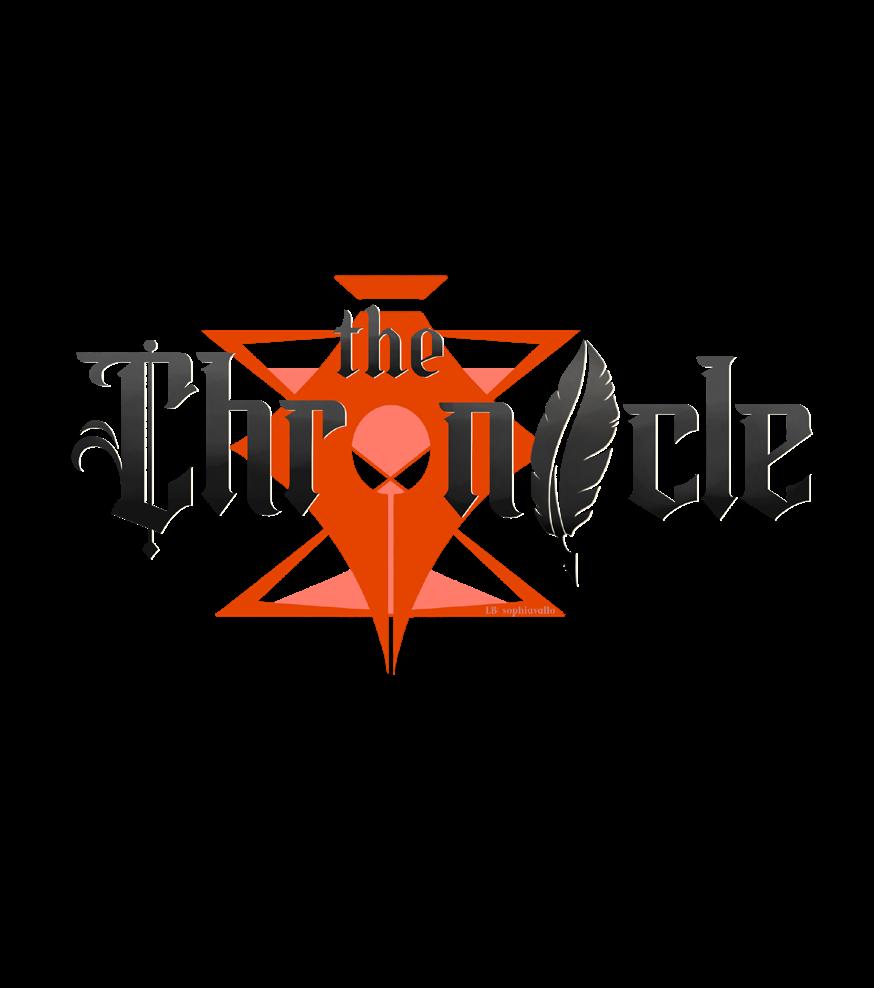
They were followed by the 1st runners-up, 12 HUMSS Brocka led by Arbien C. Lepura. Her team displayed grit and determination, challenging their opponents with every play. The 2nd runners-up, 11 Shakespeare fought hard with their team leader, Iñigo Luis D. Bulabog.
The tournament also honored individual brilliance by
naming the Mythical 6, a selection of the top-performing players. They are Iñigo Luis D. Bulabog and Glen Anjelo Dela Cruz from 11 Shakespeare, Ramil John G. Fabro from 12 ABM Taylor, Arbien C. Lepura from 12 HUMSS Brocka, Elijah Rain N. Redofia from 11 CSS Gates, and their MVP Rusty Bryan V. Galvan from 11 Animation.
11 Animation’s Rusty Bryan V. Galvan won the Most Valuable Player (MVP) award in the competition. He was a key player in his team’s championship run because of his exceptional athleticism, leadership, and adaptability.
This volleyball tournament celebrated teamwork and sportsmanship. Every game had its exciting moments that kept the audience interested, and the players gave their best on the field. With the high bar established by this year’s championship, both players and audience were looking forward to another season of thrilling volleyball action.